Julien Discrit

10'18"
Produced with the support of the Fondation des artistes
Photography & Editing: Christophe Acker
Link to the video :
https://vimeo.com/874078574/6d789c3ba9?share=copy

25:34
With (in order of appearance) : Sandy, Irene, Jose, Dinora, Anita, Floyd, Robert, Leon, Frank, Selma, Nancy
Directed by Julien Discrit
Produced by Christophe Acker and Julien Discrit
Executive Producer : That Film
Written by Julien Discrit
Cinematography by Christophe Acker
Sound by Gary Day
Edited by Christophe Acker and Julien Discrit
Post-production sound by Clément Chauvelle
Original Music by Julien Discrit
Additionnal music:
"An Empty Bliss Beyond This World"
Written and Performed by The Caretaker
(P) 2011 History Always Favours the Winners
Courtesy of History Always Favours the Winners
"Gracias a la Vida"
Written by Violeta Parra
Performed by Mercedes Sosa
1971 Phonogram S.A.I.C.
Courtesy of Universal Music Group
Filmed at Town Square® The George G. Glenner Center, San Diego, CA. USA
Special Thanks to: The participants and families of The George G. Glenner center, The staff of Town Square® facility, Scott J.Tarde, Lisa D. Tyburski, Gloria de Aragón Baker and Bella Buenrrostro. Mélissa Demontigny Hinkin and her lovely family. Julie Ripoll, Alliance Française de San Diego, Olivier Le Falher and french cultural services of New York City. Laurence Maynier, Caroline Cournède. Anne Stenne, Angèle Levet Stenne, Samuel Levet Stenne, Héctor Castells, Florence Cohen, Anne-Sarah Bénichou, Louise Daviot , Olivia Grandperrin.
Produced with the support of DRAC Île-de-France, Villa Albertine, Fondation des Artistes, Paris
©2025 Julien Discrit/That Film
All rights reserved
This film is dedicated to all the participants who have left us, and to their loved ones
In loving memory of André Roblet
Edited Memories takes us inside a memory care center for people with Alzheimer's disease in San Diego, California. Built on the principles of reminiscence therapy, the facility recreates a complete 1950s-60s environment - diner, local pub, pet store, public square - designed to provide an immersive experience. Everything here is fabricated, or rather, everything is fiction. The film observes this unusual therapeutic setting where artificial décor blends with residents' authentic memories, blurring the line between documentary and staged performance. The words we hear, repetitive and fragile, expose the place's essential ambiguity: care facility or film set? Patients or actors replaying their own lives? Through deliberate editing choices, this confusion turns the center into a soundstage where memory becomes performance, where remembering merges with its therapeutic reenactment. The film asks what happens to our life stories when memory fails, when recollections fade—suspended between lived experience and constructed narrative. Yet it seeks to reveal what remains: each person's irreducible singularity.

56,8 x 56,8 x 1 cm
Reminiscence Disk (2058) is part of a series of works entitled Edited Memories, a continuation of the artist's research into memory. The project, conceived as a whole, focuses in particular on reminiscence therapy, a term used to define a device for people suffering from memory disorders. This is defined by the use of objects, prompts or even environments that can stimulate memories that are still present. This series of strangely patterned coloured discs takes on the characteristics of therapeutic material designed for cerebral stimulation. These discs are like recordings of lost memories, reactivated by contact with the shapes engraved on their surface.

56,8 x 56,8 x 1 cm
Reminiscence Disk (2058) is part of a series of works entitled Edited Memories, a continuation of the artist's research into memory. The project, conceived as a whole, focuses in particular on reminiscence therapy, a term used to define a device for people suffering from memory disorders. This is defined by the use of objects, prompts or even environments that can stimulate memories that are still present. This series of strangely patterned coloured discs takes on the characteristics of therapeutic material designed for cerebral stimulation. These discs are like recordings of lost memories, reactivated by contact with the shapes engraved on their surface.

56,8 x 56,8 x 1 cm
Reminiscence Disk (2058) is part of a series of works entitled Edited Memories, a continuation of the artist's research into memory. The project, conceived as a whole, focuses in particular on reminiscence therapy, a term used to define a device for people suffering from memory disorders. This is defined by the use of objects, prompts or even environments that can stimulate memories that are still present. This series of strangely patterned coloured discs takes on the characteristics of therapeutic material designed for cerebral stimulation. These discs are like recordings of lost memories, reactivated by contact with the shapes engraved on their surface.

Image: 40 x 50 cm
Forever Reverb (1958) is part of a series of works entitled Edited Memories, a continuation of the artist's research into memory. The project, conceived as a whole, focuses in particular on reminiscence therapy, a term used to define a device for people suffering from memory disorders. This is defined by the use of objects, prompts or even environments that can stimulate memories that are still present. The photographs were taken on the set of a film depicting life in a Memory Care Centre, a gigantic set mimicking the 1950s (the reference year is 1958), where people, most of them suffering from Alzheimer's disease, live.
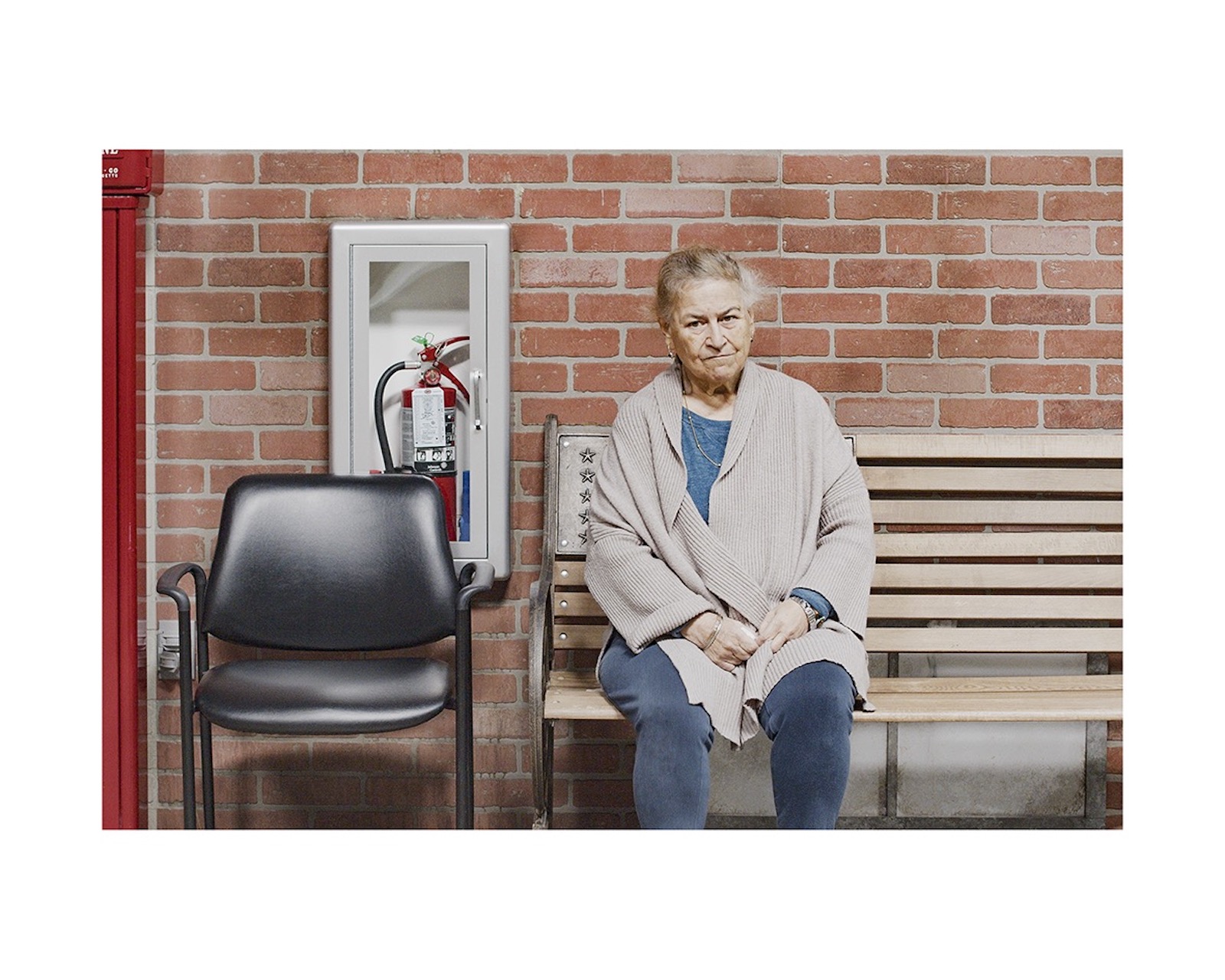
Image: 40 x 50 cm
Forever Reverb (1958) is part of a series of works entitled Edited Memories, a continuation of the artist's research into memory. The project, conceived as a whole, focuses in particular on reminiscence therapy, a term used to define a device for people suffering from memory disorders. This is defined by the use of objects, prompts or even environments that can stimulate memories that are still present. The photographs were taken on the set of a film depicting life in a Memory Care Centre, a gigantic set mimicking the 1950s (the reference year is 1958), where people, most of them suffering from Alzheimer's disease, live.
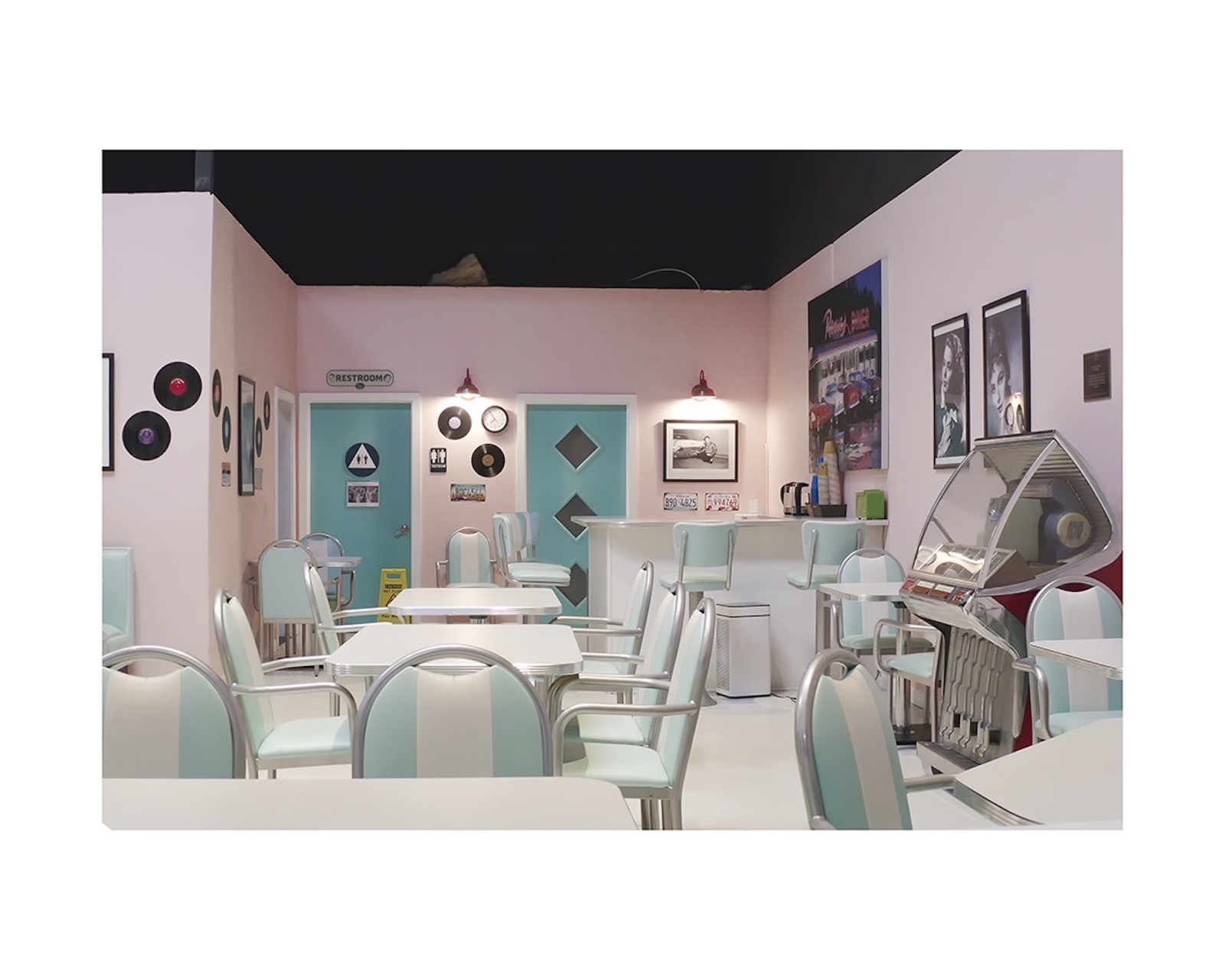
Image: 40 x 50 cm
Forever Reverb (1958) is part of a series of works entitled Edited Memories, a continuation of the artist's research into memory. The project, conceived as a whole, focuses in particular on reminiscence therapy, a term used to define a device for people suffering from memory disorders. This is defined by the use of objects, prompts or even environments that can stimulate memories that are still present. The photographs were taken on the set of a film depicting life in a Memory Care Centre, a gigantic set mimicking the 1950s (the reference year is 1958), where people, most of them suffering from Alzheimer's disease, live.

Image: 40 x 50 cm
Forever Reverb (1958) is part of a series of works entitled Edited Memories, a continuation of the artist's research into memory. The project, conceived as a whole, focuses in particular on reminiscence therapy, a term used to define a device for people suffering from memory disorders. This is defined by the use of objects, prompts or even environments that can stimulate memories that are still present. The photographs were taken on the set of a film depicting life in a Memory Care Centre, a gigantic set mimicking the 1950s (the reference year is 1958), where people, most of them suffering from Alzheimer's disease, live.

Image: 40 x 50 cm
Forever Reverb (1958) is part of a series of works entitled Edited Memories, a continuation of the artist's research into memory. The project, conceived as a whole, focuses in particular on reminiscence therapy, a term used to define a device for people suffering from memory disorders. This is defined by the use of objects, prompts or even environments that can stimulate memories that are still present. The photographs were taken on the set of a film depicting life in a Memory Care Centre, a gigantic set mimicking the 1950s (the reference year is 1958), where people, most of them suffering from Alzheimer's disease, live.

Image: 40 x 50 cm
Forever Reverb (1958) is part of a series of works entitled Edited Memories, a continuation of the artist's research into memory. The project, conceived as a whole, focuses in particular on reminiscence therapy, a term used to define a device for people suffering from memory disorders. This is defined by the use of objects, prompts or even environments that can stimulate memories that are still present. The photographs were taken on the set of a film depicting life in a Memory Care Centre, a gigantic set mimicking the 1950s (the reference year is 1958), where people, most of them suffering from Alzheimer's disease, live.

50 x 40 cm
Titled, dated, signed at the back
The serie Aftertouch is a continuation of Julien Discrit's work on self-generated forms. The artist uses a process of molding and imprinting, which, by contact, allows him to obtain random forms. These arborescences, or "dendrites", recall forms discernible in many physical and natural phenomena such as neural networks, veins, plants... or geographical as in erosion and hydrographic networks. Motifs already present in other series of the artist such as the États inversés and Mille Mississippi. The title Aftertouch evokes the imprinting process used, since the forms are self-generated after contact, and also refers to sound, more precisely to electronic keyboards and synthesizers, the "aftertouch" being an effect that plays on the sensitivity of expression of the key of a keyboard to create a variation of note.
-
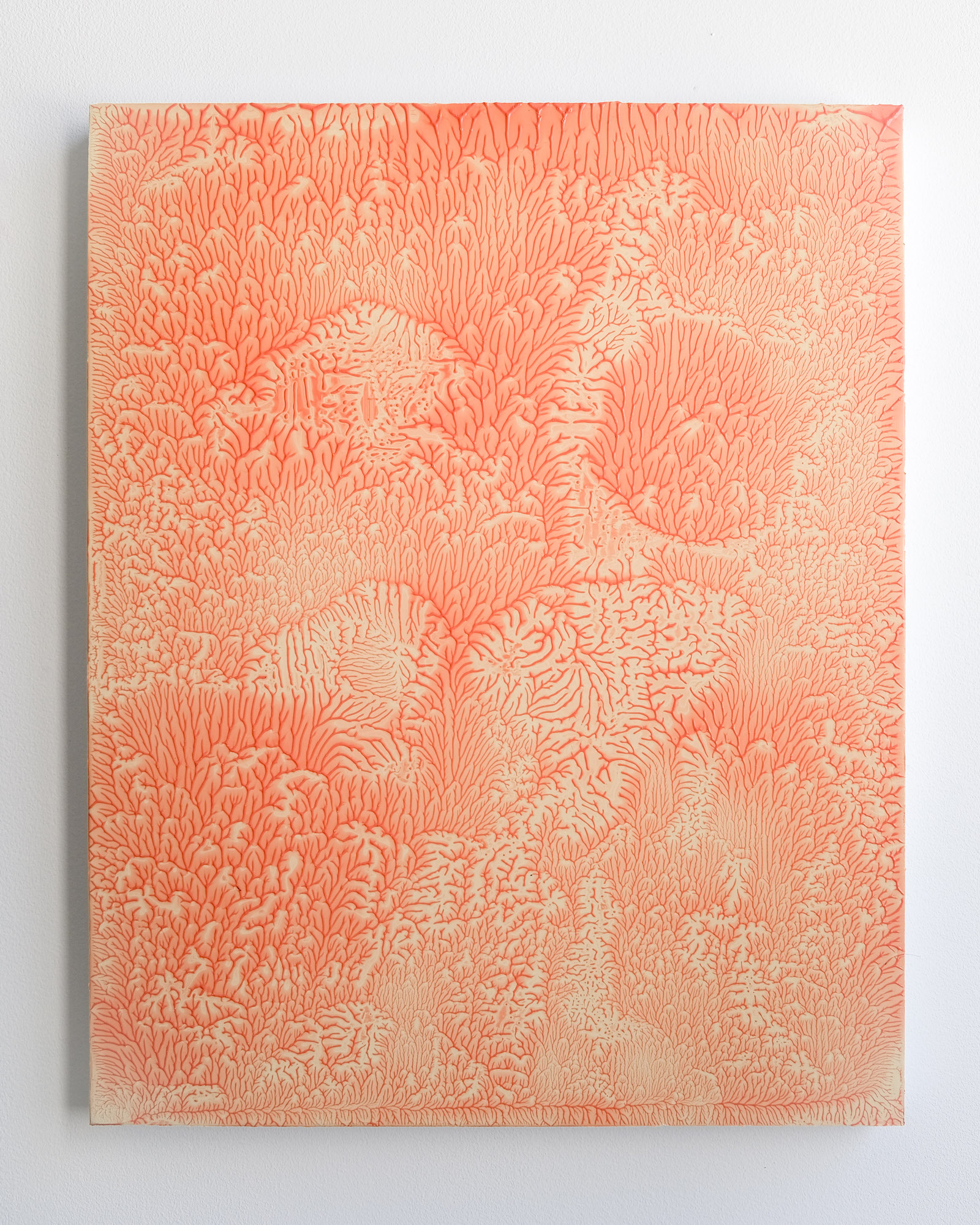
50 x 40 cm
Titled, dated, signed at the back
The serie Aftertouch is a continuation of Julien Discrit's work on self-generated forms. The artist uses a process of molding and imprinting, which, by contact, allows him to obtain random forms. These arborescences, or "dendrites", recall forms discernible in many physical and natural phenomena such as neural networks, veins, plants... or geographical as in erosion and hydrographic networks. Motifs already present in other series of the artist such as the États inversés and Mille Mississippi.
The title Aftertouch evokes the imprinting process used, since the forms are self-generated after contact, and also refers to sound, more precisely to electronic keyboards and synthesizers, the "aftertouch" being an effect that plays on the sensitivity of expression of the key of a keyboard to create a variation of note.
-
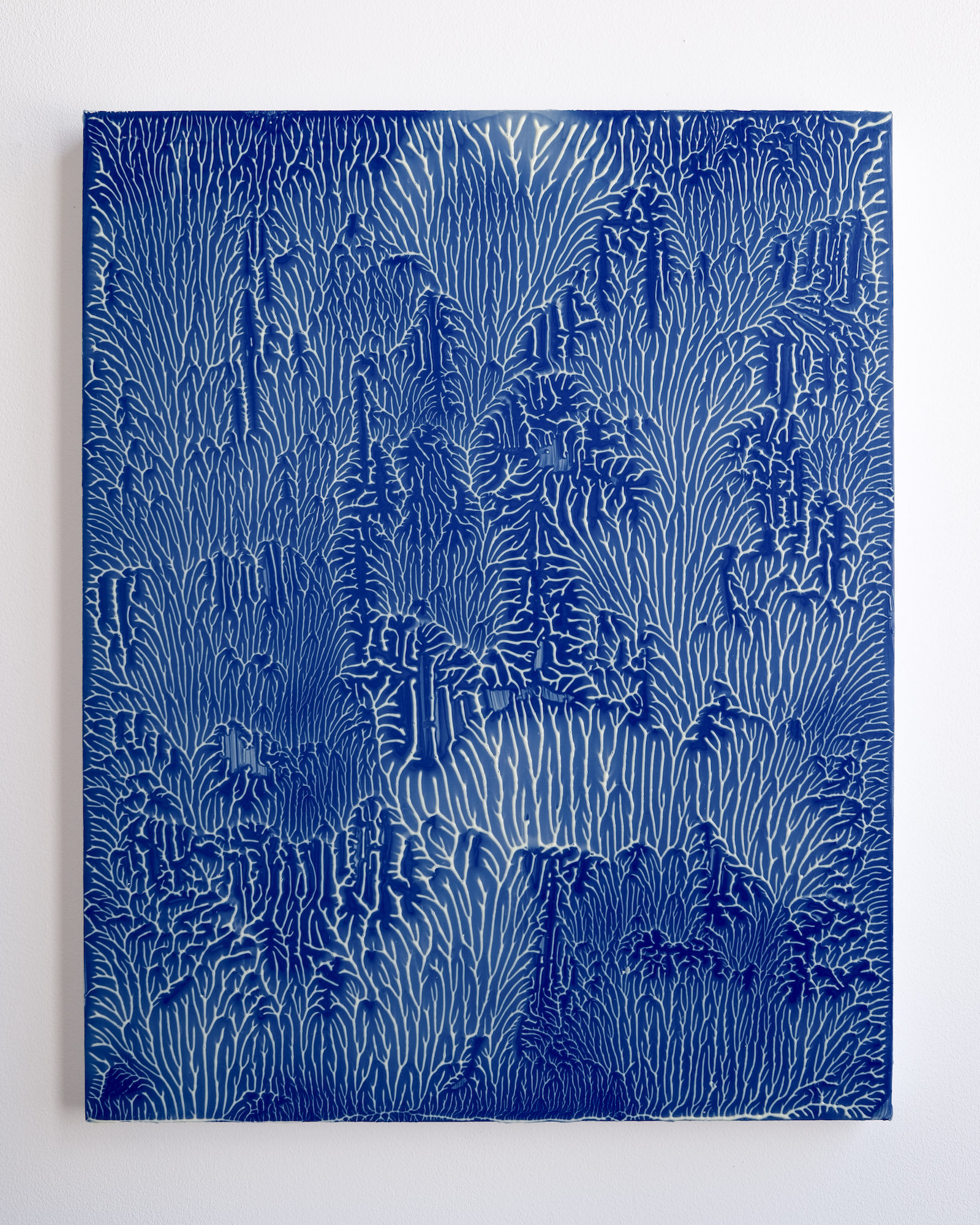
50 x 40 cm
Titled, dated, signed at the back
The serie Aftertouch is a continuation of Julien Discrit's work on self-generated forms. The artist uses a process of molding and imprinting, which, by contact, allows him to obtain random forms. These arborescences, or "dendrites", recall forms discernible in many physical and natural phenomena such as neural networks, veins, plants... or geographical as in erosion and hydrographic networks. Motifs already present in other series of the artist such as the États inversés and Mille Mississippi.
The title Aftertouch evokes the imprinting process used, since the forms are self-generated after contact, and also refers to sound, more precisely to electronic keyboards and synthesizers, the "aftertouch" being an effect that plays on the sensitivity of expression of the key of a keyboard to create a variation of note.
-
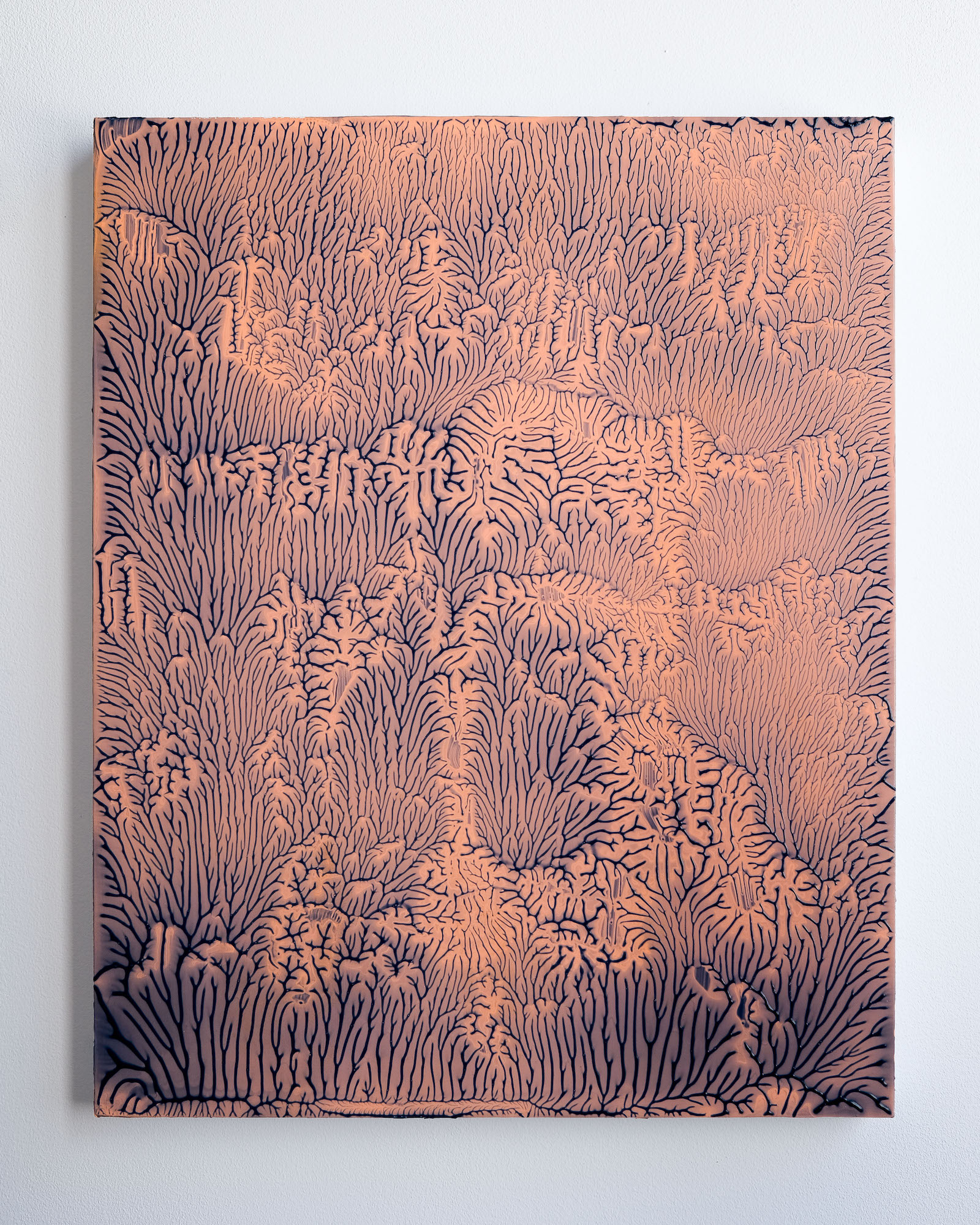
50 x 40 cm
Titled, dated, signed at the back
The serie Aftertouch is a continuation of Julien Discrit's work on self-generated forms. The artist uses a process of molding and imprinting, which, by contact, allows him to obtain random forms. These arborescences, or "dendrites", recall forms discernible in many physical and natural phenomena such as neural networks, veins, plants... or geographical as in erosion and hydrographic networks. Motifs already present in other series of the artist such as the États inversés and Mille Mississippi.
The title Aftertouch evokes the imprinting process used, since the forms are self-generated after contact, and also refers to sound, more precisely to electronic keyboards and synthesizers, the "aftertouch" being an effect that plays on the sensitivity of expression of the key of a keyboard to create a variation of note.
-

110 x 80 cm
Signed, titled, dated at the back
The serie Aftertouch is a continuation of Julien Discrit's work on self-generated forms. The artist uses a process of molding and imprinting, which, by contact, allows him to obtain random forms. These arborescences, or "dendrites", recall forms discernible in many physical and natural phenomena such as neural networks, veins, plants... or geographical as in erosion and hydrographic networks. Motifs already present in other series of the artist such as the États inversés and Mille Mississippi.
The title Aftertouch evokes the imprinting process used, since the forms are self-generated after contact, and also refers to sound, more precisely to electronic keyboards and synthesizers, the "aftertouch" being an effect that plays on the sensitivity of expression of the key of a keyboard to create a variation of note.
-

120 x 100 cm
Signed, titled, dated at the back
The serie Aftertouch is a continuation of Julien Discrit's work on self-generated forms. The artist uses a process of molding and imprinting, which, by contact, allows him to obtain random forms. These arborescences, or "dendrites", recall forms discernible in many physical and natural phenomena such as neural networks, veins, plants... or geographical as in erosion and hydrographic networks. Motifs already present in other series of the artist such as the États inversés and Mille Mississippi.
The title Aftertouch evokes the imprinting process used, since the forms are self-generated after contact, and also refers to sound, more precisely to electronic keyboards and synthesizers, the "aftertouch" being an effect that plays on the sensitivity of expression of the key of a keyboard to create a variation of note.
-
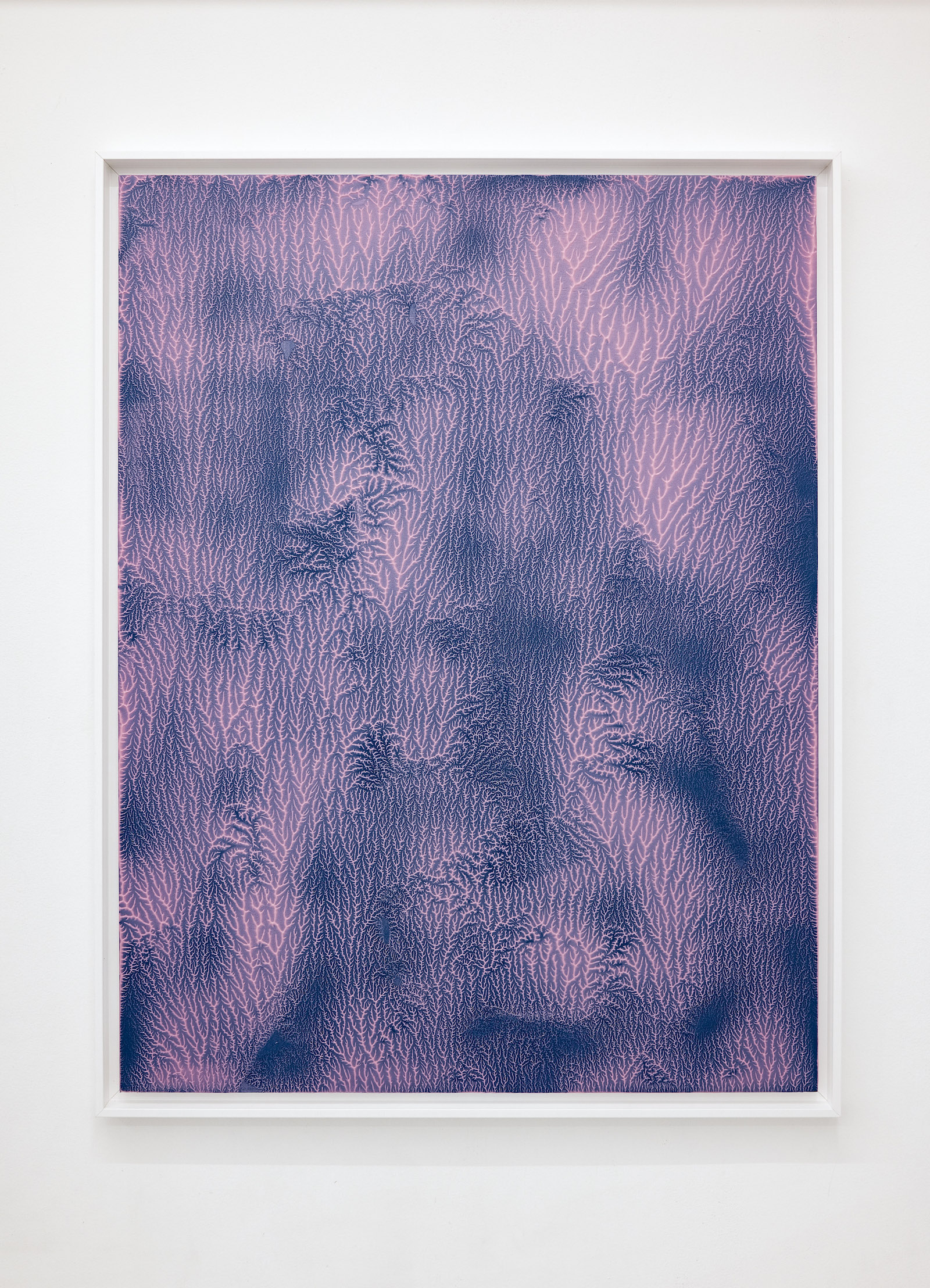
105 x 80 cm
Titled, signed, dated on the back
The serie Aftertouch is a continuation of Julien Discrit's work on self-generated forms. The artist uses a process of molding and imprinting, which, by contact, allows him to obtain random forms. These arborescences, or "dendrites", recall forms discernible in many physical and natural phenomena such as neural networks, veins, plants... or geographical as in erosion and hydrographic networks. Motifs already present in other series of the artist such as the États inversés and Mille Mississippi.
The title Aftertouch evokes the imprinting process used, since the forms are self-generated after contact, and also refers to sound, more precisely to electronic keyboards and synthesizers, the "aftertouch" being an effect that plays on the sensitivity of expression of the key of a keyboard to create a variation of note.
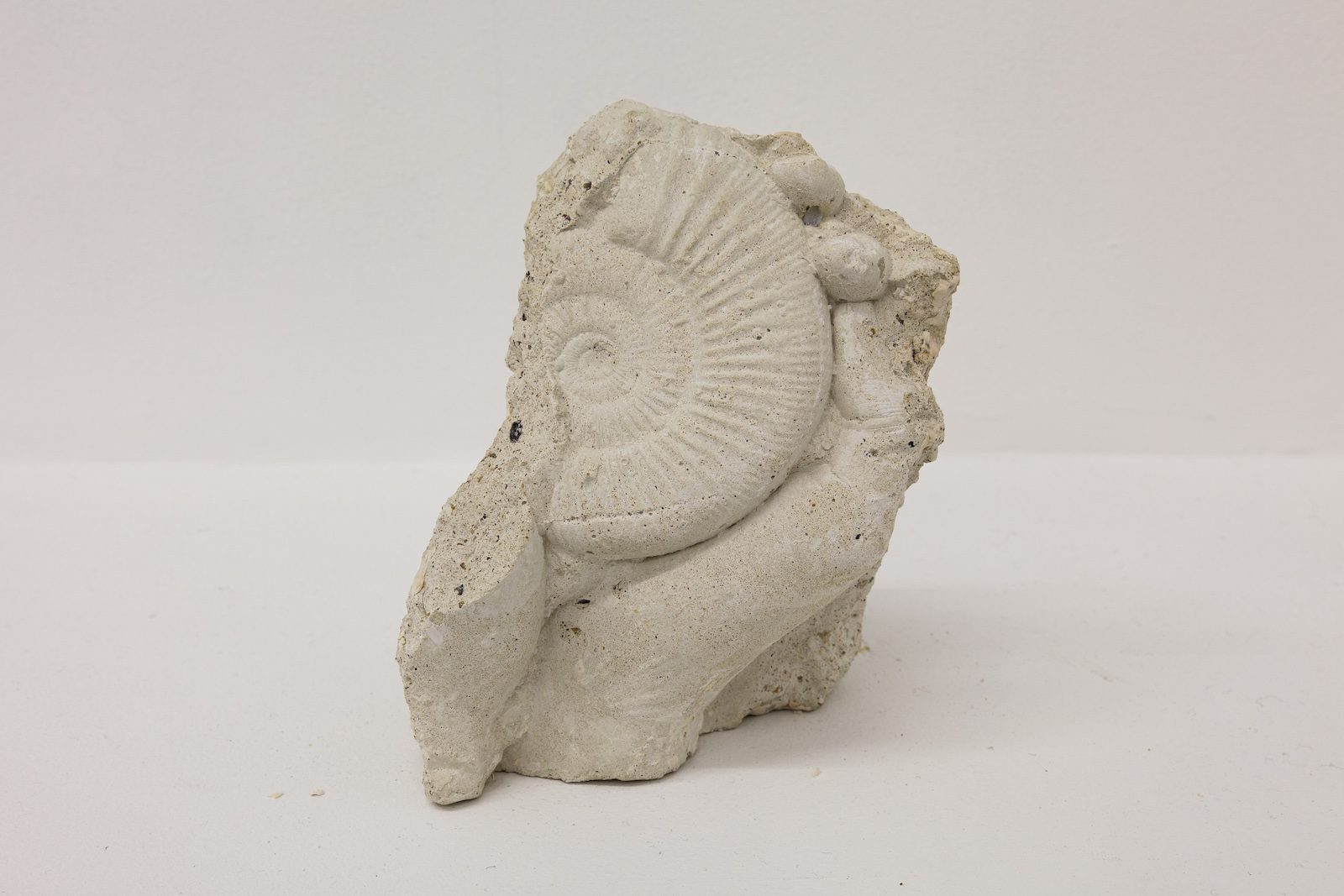
Reconstituted stone
18,5 x 14,5 x 13 cm
The series of sculptures grouped together under the name "Re-member" is, for Julien Discrit, an opportunity to pursue his research on the mineral in its relationship to time and body. These sculptures most often show hands holding fossilised or crystallised rocks. They come to elucidate an almost archaic gesture of gripping.
In a snapshot, they propose a "becoming stone" that plays with both materials - organic and mineral mixed together in yet another - but also with artistic and historical practices.
Through this anachronistic gesture, the artist reproduces identically a process of fossilization that could be described as "natural", consisting of depositing an imprint in a material that receives it. In other words, a casting. However, the forms obtained here take on the appearance of a possible metamorphosis, of an image stopped within a continuum where the material is constantly transforming and recombining.
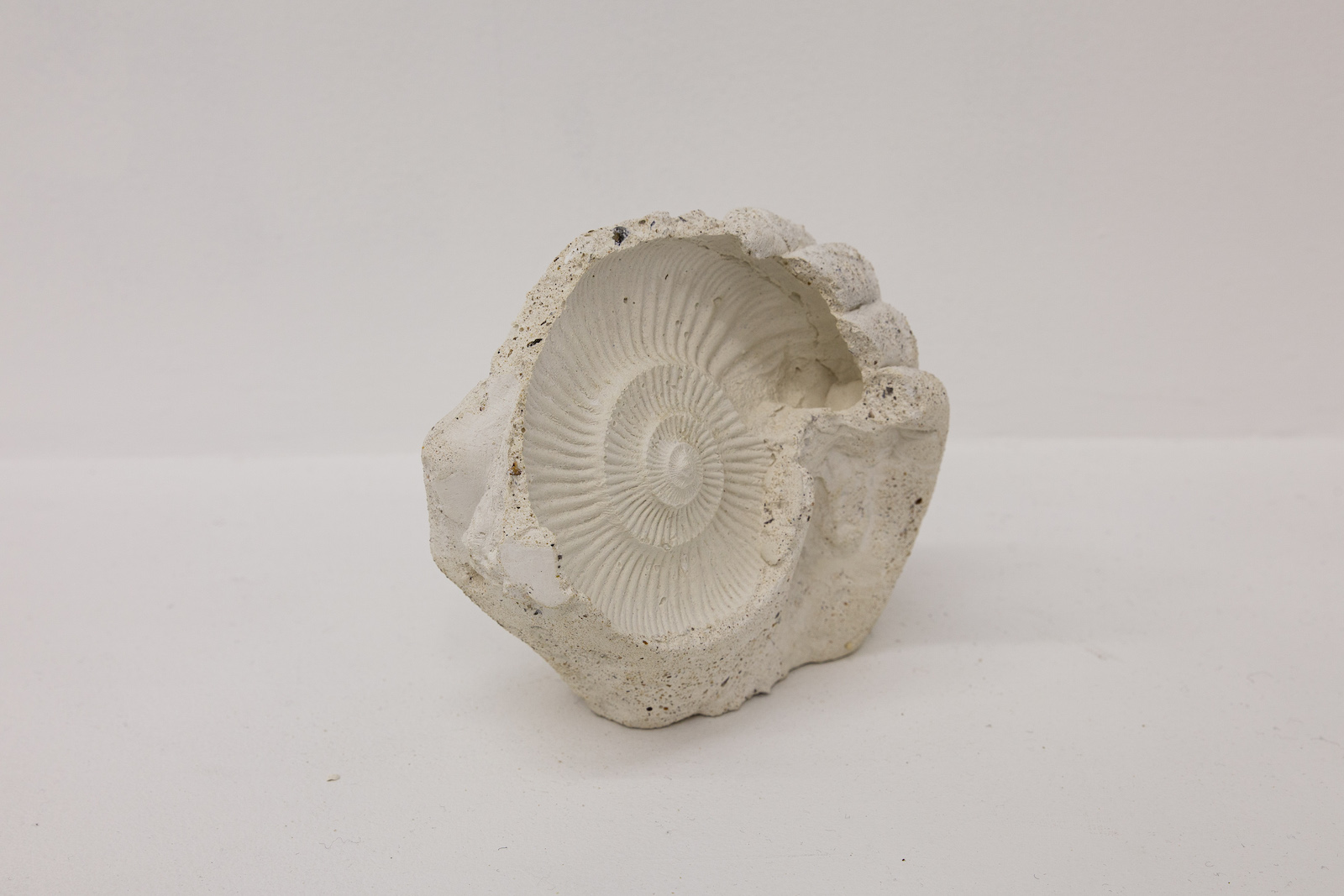
Reconstituted stone
15 x 17 x 11 cm
The series of sculptures grouped together under the name "Re-member" is, for Julien Discrit, an opportunity to pursue his research on the mineral in its relationship to time and body. These sculptures most often show hands holding fossilised or crystallised rocks. They come to elucidate an almost archaic gesture of gripping. In a snapshot, they propose a "becoming stone" that plays with both materials - organic and mineral mixed together in yet another - but also with artistic and historical practices.
Through this anachronistic gesture, the artist reproduces identically a process of fossilization that could be described as "natural", consisting of depositing an imprint in a material that receives it. In other words, a casting. However, the forms obtained here take on the appearance of a possible metamorphosis, of an image stopped within a continuum where the material is constantly transforming and recombining.

Reconstituted stone
15 x 17 x 11 cm
The series of sculptures grouped together under the name "Re-member" is, for Julien Discrit, an opportunity to pursue his research on the mineral in its relationship to time and body. These sculptures most often show hands holding fossilised or crystallised rocks. They come to elucidate an almost archaic gesture of gripping. In a snapshot, they propose a "becoming stone" that plays with both materials - organic and mineral mixed together in yet another - but also with artistic and historical practices.
Through this anachronistic gesture, the artist reproduces identically a process of fossilization that could be described as "natural", consisting of depositing an imprint in a material that receives it. In other words, a casting. However, the forms obtained here take on the appearance of a possible metamorphosis, of an image stopped within a continuum where the material is constantly transforming and recombining.

Reconstituted stone
16 x 17 x 13 cm
The series of sculptures grouped together under the name "Re-member" is, for Julien Discrit, an opportunity to pursue his research on the mineral in its relationship to time and body. These sculptures most often show hands holding fossilised or crystallised rocks. They come to elucidate an almost archaic gesture of gripping. In a snapshot, they propose a "becoming stone" that plays with both materials - organic and mineral mixed together in yet another - but also with artistic and historical practices.
Through this anachronistic gesture, the artist reproduces identically a process of fossilization that could be described as "natural", consisting of depositing an imprint in a material that receives it. In other words, a casting. However, the forms obtained here take on the appearance of a possible metamorphosis, of an image stopped within a continuum where the material is constantly transforming and recombining.
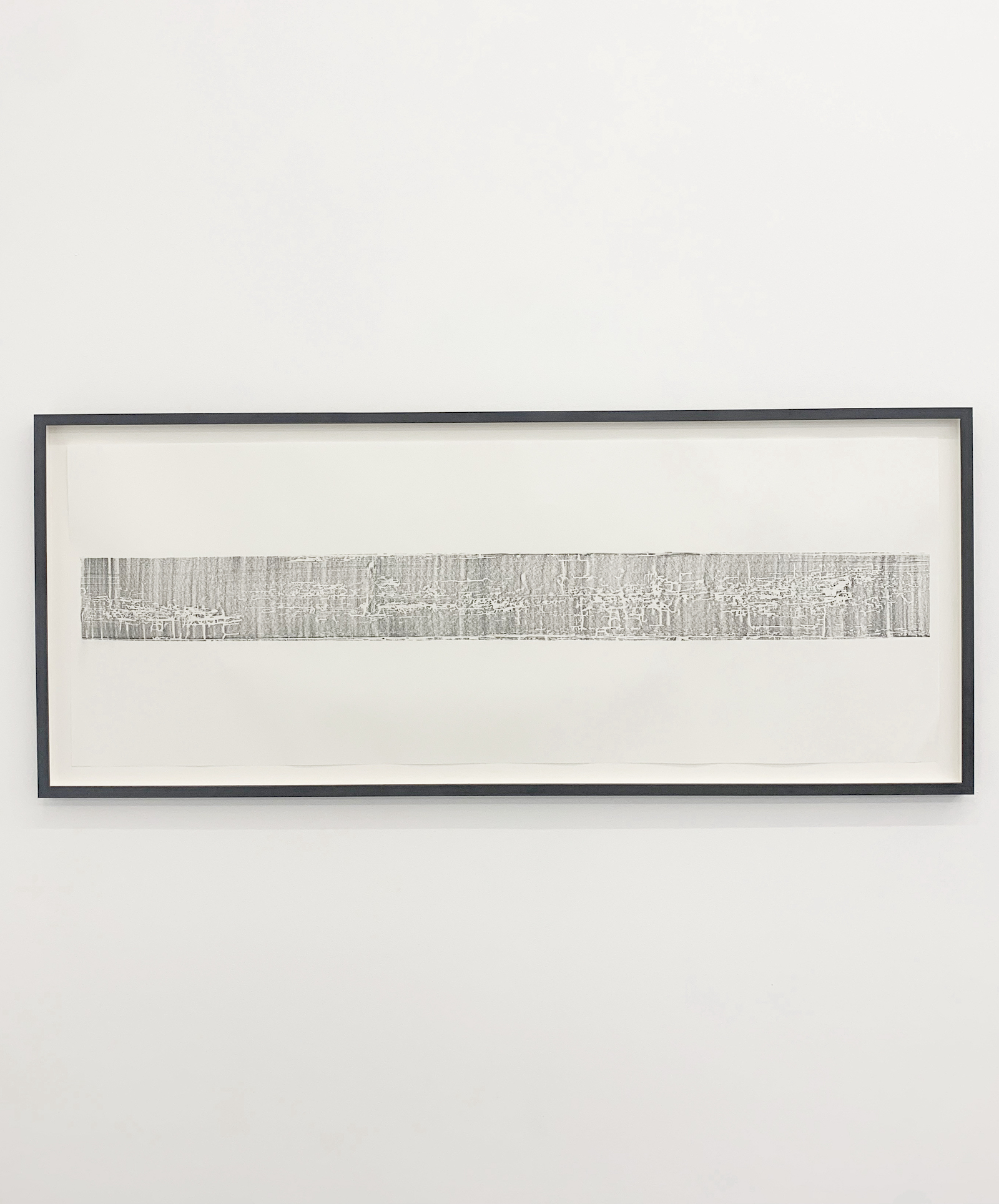
44 x 118,5 cm
Cette oeuvre s'inscrit dans la continuité de la série des Pensées ou des Chants d'oiseaux ; des autogénérées, faites de traces et de cheminements rendent l'intervention artistique dépendante de facteurs aléatoires. Réalisée à partir du frottage d'une planche de parquet à la mine de plomb, elle vient sublimer les nervures du bois et les galeries creusées par les insectes, composant autant de motifs évoquant un dessin ou bien une forme d'écriture mystérieuse.

147 x 110 cm
Cette oeuvre s'inscrit dans la continuité de la série des Pensées ou des Chants d'oiseaux ; des formes autogénérées, faites de traces et de cheminements rendent l'intervention artistique dépendante de facteurs aléatoires. Réalisée à partir du frottage de planches de parquet à la mine de plomb, elle vient sublimer les nervures du bois et les galeries creusées par les insectes, composant autant de motifs évoquant un dessin ou bien une forme d'écriture mystérieuse.

21 x 13 cm
Each Diagram offers the story of a selected dream made by the artist, realised on a notebook page. By removing the ribbon from a typewriter, the paper has been carved to create the letters and the words which make these scripts visible for our eyes.
Text
Dans un pays d'Amérique du sud se trouve un site
naturel exceptionnel.
Au milieu de montagnes recouvertes par la jungle
se dresse une gigantesque falaise. Cet éperon
rocheux domine une large vallée.
Il est formé par une grande arche dont la partie
supérieure est parfaitement plane. A l'extrémité
de celle-ci se trouve un énorme bloc de roche
en forme de triangle, en équilibre au-dessus du
vide. Il semble prêt à se détacher à tout
instant.L'arche forme comme deux immenses doigts
de pierre, l'empêchant de basculer.
J'apprends alors que les habitants de ces
montagnes l'appellent :
« La table de Dieu »
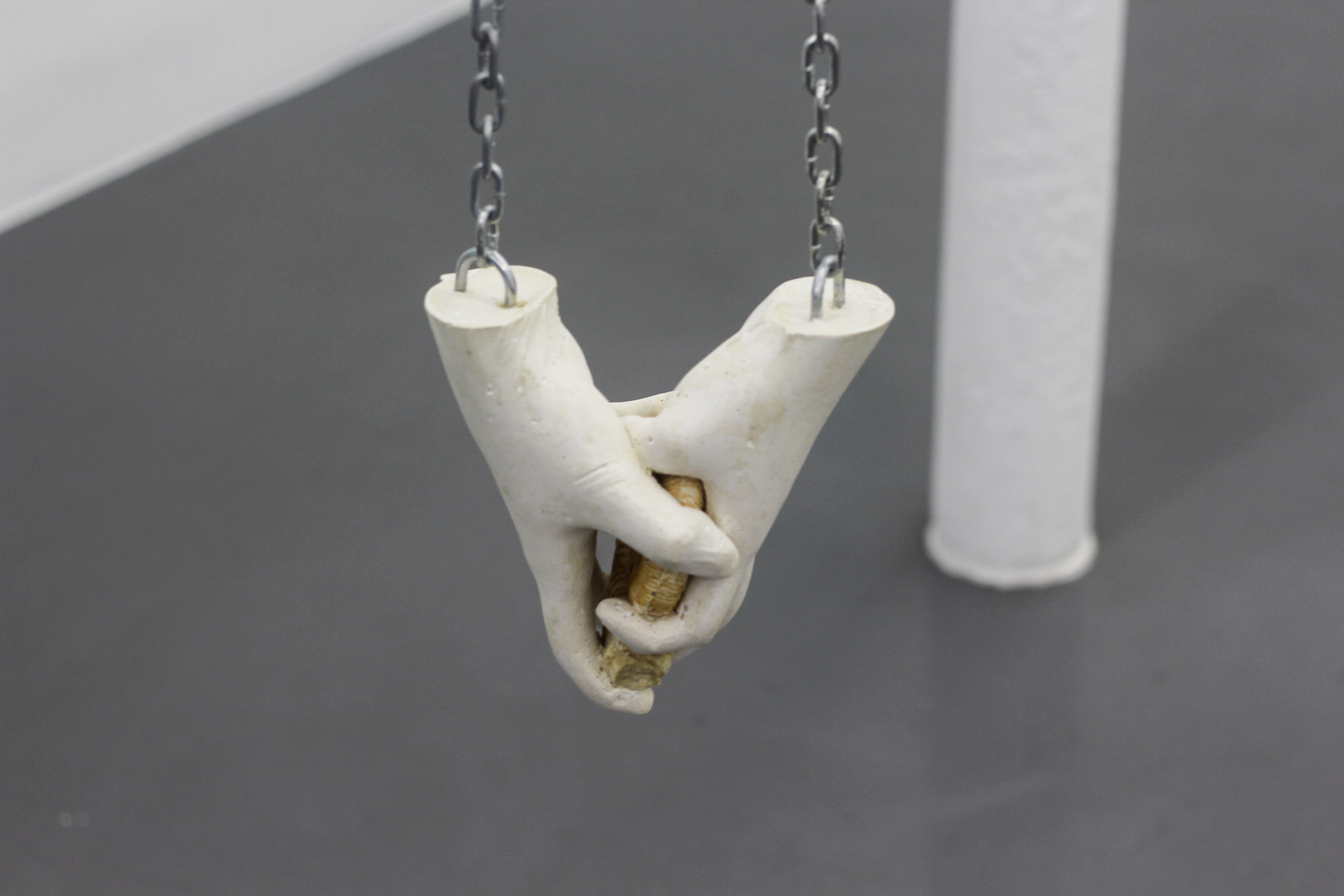
acrylic resin, shellac, chains
246 x 20 x 14 cm
Pour l'exposition anniversaire de la galerie, Julien Discrit a réalisé une oeuvre qui s'inscrit dans la continuité de son travail sur les mains et la géologie, notamment sa série Pierres. Intitulée Re-member, cette nouvelle série se situe moins dans un jeu sur la roche que sur les thématiques de l'empreinte et du contact. L'origine du mot Re-member provient du vieux français « re-membrer », liaison sémantique entre le souvenir et les parties du corps. Dans cette sculpture, les deux mains tentent de se toucher autour de cette ammonite, sans pour autant y parvenir. Induisant longévité et fidélité, ce fossile créé de toute pièce symbolise l'histoire de l'artiste avec la galerie.
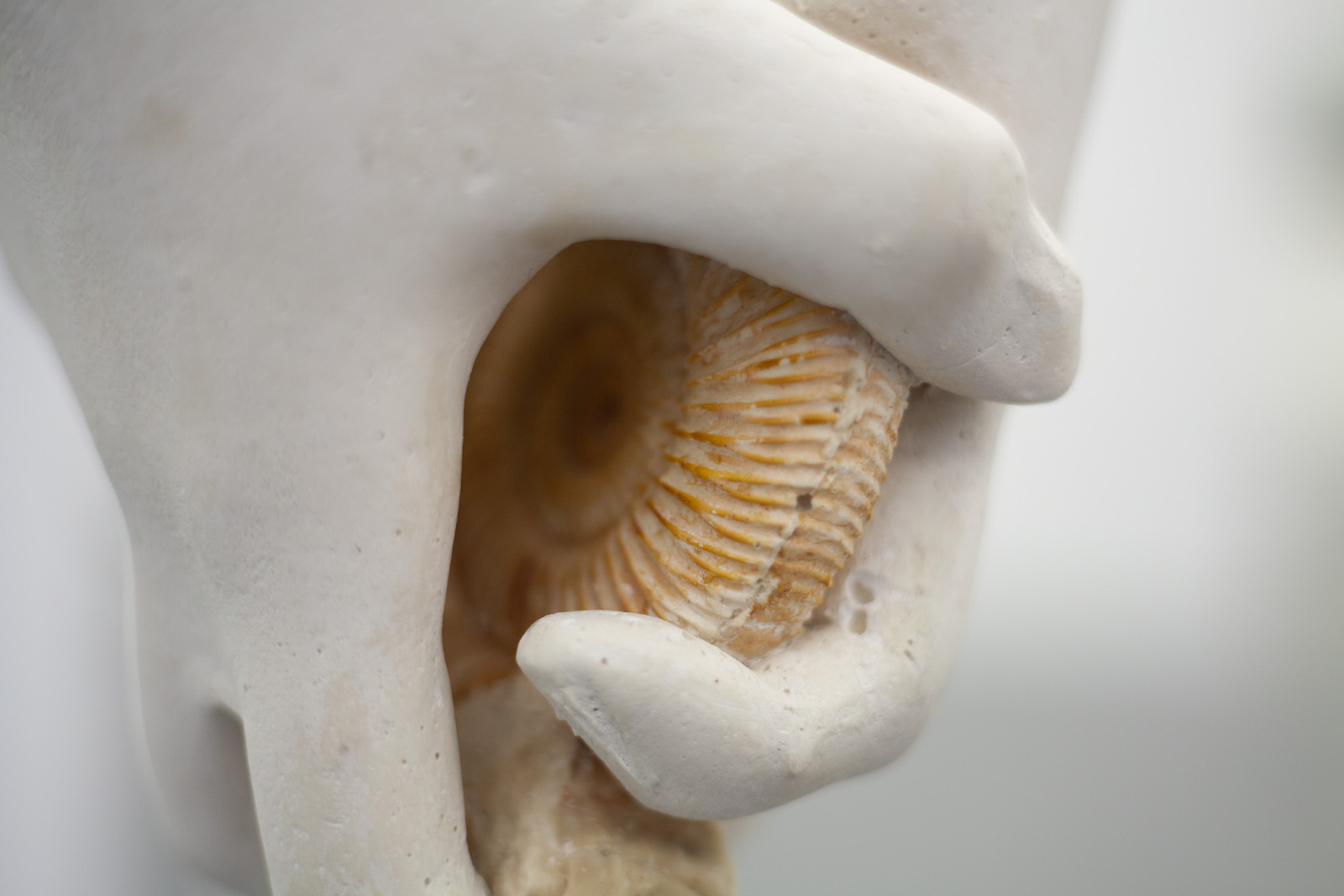
acrylic resin, shellac, chains
246 x 20 x 14 cm
Pour l'exposition anniversaire de la galerie, Julien Discrit a réalisé une oeuvre qui s'inscrit dans la continuité de son travail sur les mains et la géologie, notamment sa série Pierres. Intitulée Re-member, cette nouvelle série se situe moins dans un jeu sur la roche que sur les thématiques de l'empreinte et du contact. L'origine du mot Re-member provient du vieux français « re-membrer », liaison sémantique entre le souvenir et les parties du corps. Dans cette sculpture, les deux mains tentent de se toucher autour de cette ammonite, sans pour autant y parvenir. Induisant longévité et fidélité, ce fossile créé de toute pièce symbolise l'histoire de l'artiste avec la galerie.

161 x 230 x 105 cm
Sophie Robichon
L'ange de Nagasaki is a reconstitution of a statue damaged by the atomic bomb dropped on Nagasaki 9 August 1945. The truncated face of the Angel of Nagasaki is reconstituted here by the artist who presents the half of it that has been destroyed. Produced in a giant block of white marble, this missing piece potentially repairs the figure of the Angel; it is a spectral and celestial alter ego of the human figure. The play on scale ratio adds to this reconstitution the strength of monument, reinforcing its symbolic dimension.
This artwork has been produced within the frame and the support of the 1% du marché de l'Art project.

161 x 230 x 105 cm
Sophie Robichon
Installation L'oubli des formes, l'empreinte demeure, 1% du marché de l'art Photo © Sophie Robichon
L'ange de Nagasaki is a reconstitution of a statue damaged by the atomic bomb dropped on Nagasaki 9 August 1945. The truncated face of the Angel of Nagasaki is reconstituted here by the artist who presents the half of it that has been destroyed. Produced in a giant block of white marble, this missing piece potentially repairs the figure of the Angel; it is a spectral and celestial alter ego of the human figure. The play on scale ratio adds to this reconstitution the strength of monument, reinforcing its symbolic dimension.
This artwork has been produced within the frame and the support of the 1% du marché de l'Art project.

39,5 x 60 x 40 cm
The Mitate sculptures have been initially produced for an installation named L'oubli des formes, l'empreinte demeure. The latter took a direct inspiration from Japanese garden Art, and more precisely from Zen gardens. Julien Discrit uses the principle of standing stones visible from a slightly elevated position, typical of Zen meditation.
While this project does not pretend to faithfully recreate Japanese temple, the colorized monoliths are reproductions of rocks composing the Komyo-in, a Buddhist temple located in Kyoto. The artist made 3D scan of the stones which, by a work of machining and moulding with resin, can find a form of iteration. If the forms have been moved from Japan to Paris, the graphical aspect of these stones become sculptures is the result of a research on flow, fluid and marbling.
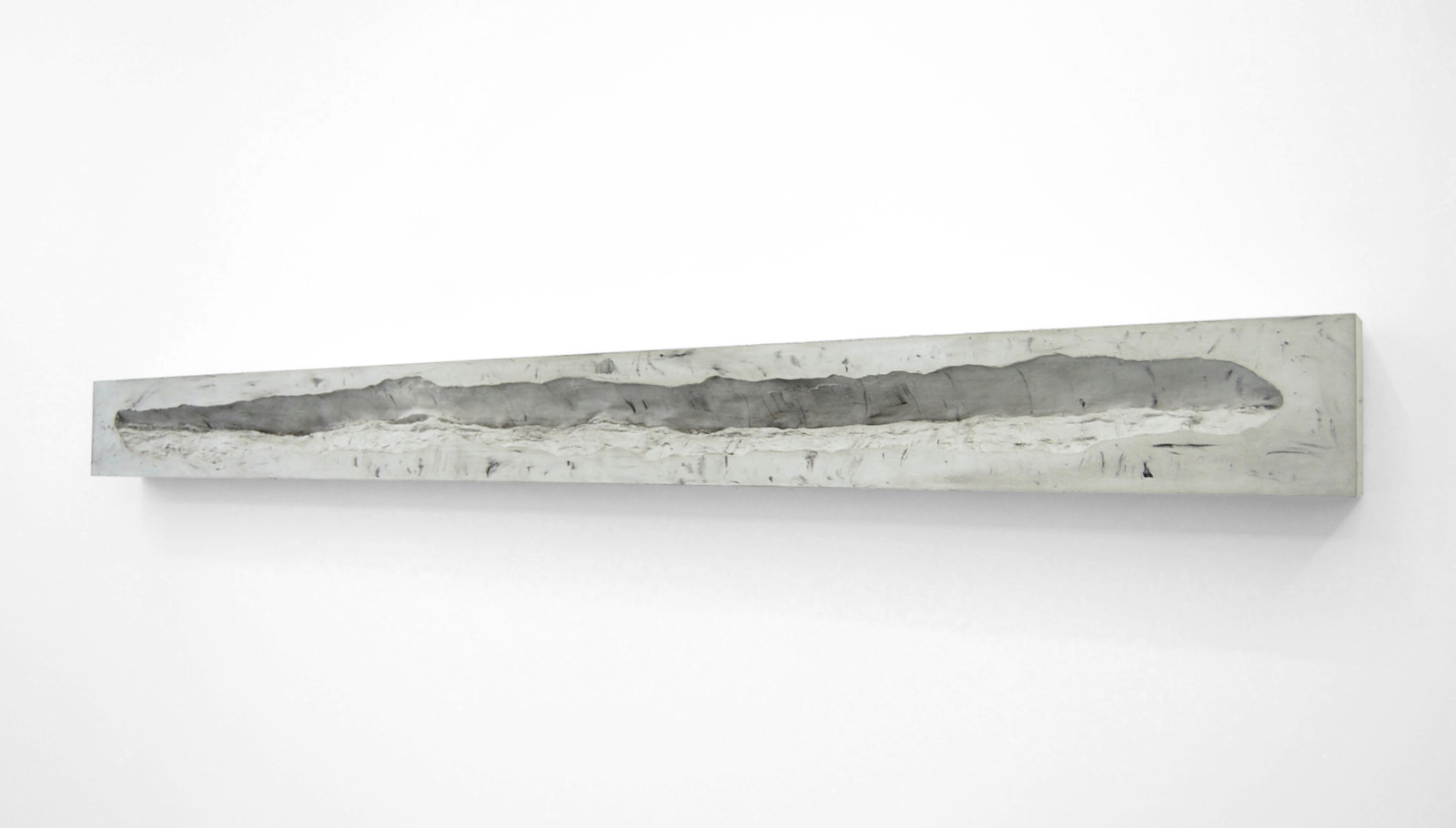
In the continuity of his works around the notions of imprint and border, Julien Discrit explores the line in its historical and temporal dimension. He made a molding from one of the few visible geological imprints of the boundary between the end of the Cretaceous and the beginning of the tertiary era dating back 66 million years - a change of era notably marking the disappearance of the dinosaurs. This limit is visible on the ground by the presence of a thin layer of clay known as the K-T limit, identified in the Basque Country, at Zumaia. Julien Discrit questions here the fragility of human and animal life, the irreversibility of destruction and the question of evolution.
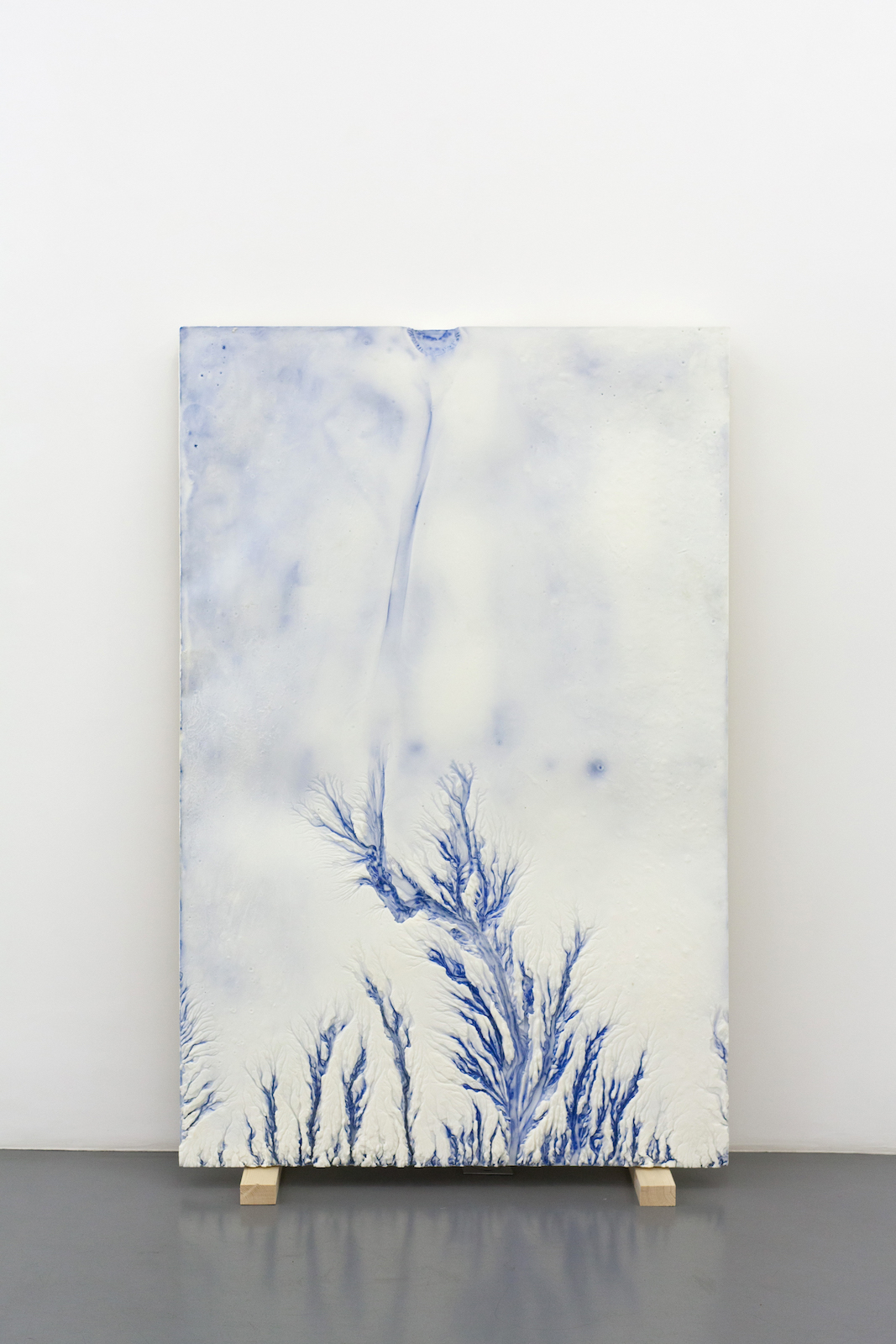
Polyurethan resin, acrylic painting
55,5 x 36 x 1,6 inch
This resin casting is the result of the slow pouring of water through a bed of silica and present the frozen image of a liquid continuum. The subtle forms as much as the traced lines seem to be the emanation of an intelligence of water, a deep network of neurons, a self-generated sculpture which responds to it own logic. Equally taking interest in the miniature and the maquette, this work pursues research initiated in older works such as États Inversées (Inverted States) or Inframince Mont-Blanc (Mont-Blanc Infrathin).
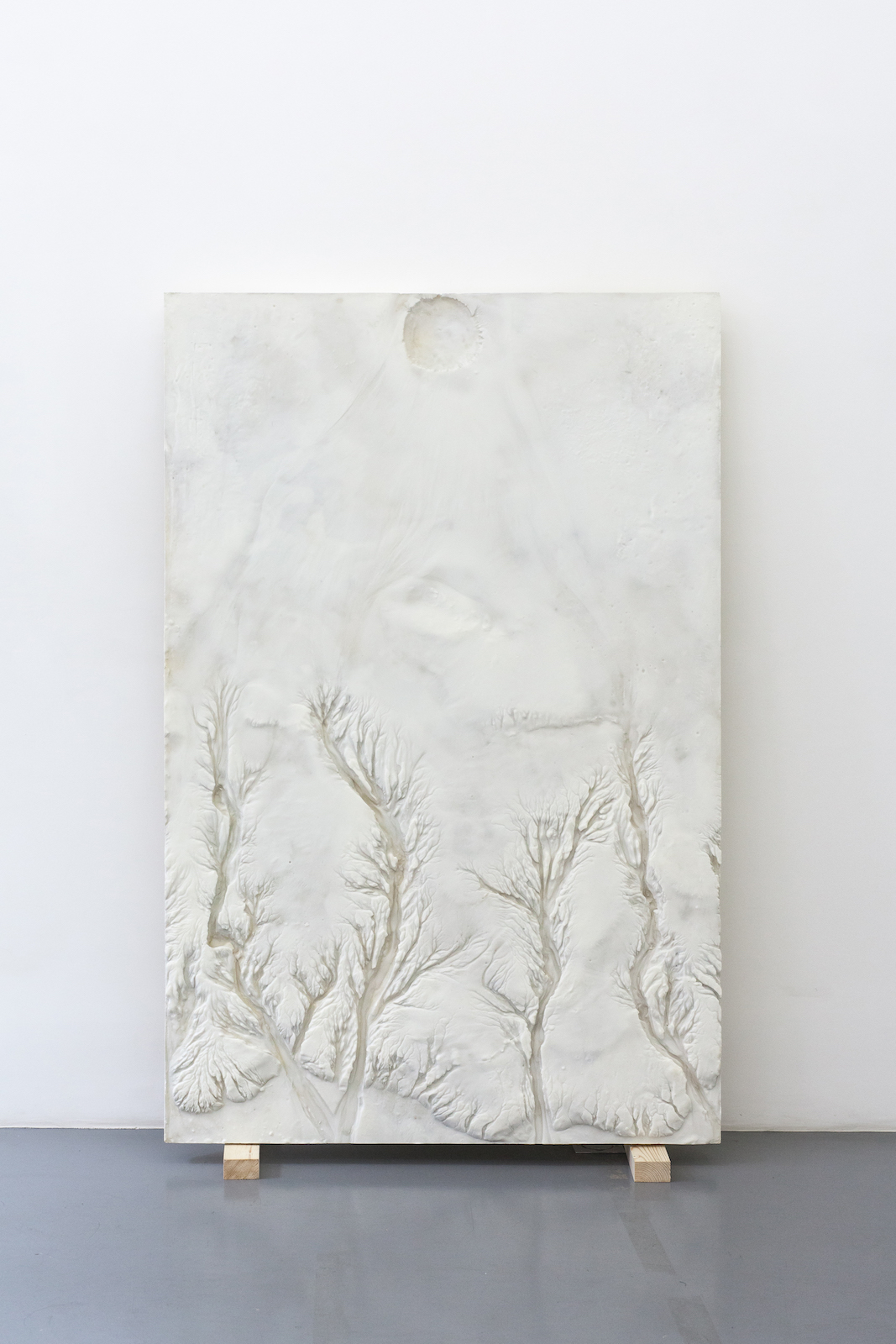
Polyurethane resin and foams, acrylic paint
145 x 91,2 x 9 cm
This resin casting is the result of the slow pouring of water through a bed of silica and present the frozen image of a liquid continuum. The subtle forms as much as the traced lines seem to be the emanation of an intelligence of water, a deep network of neurons, a self-generated sculpture which responds to it own logic. Equally taking interest in the miniature and the maquette, this work pursues research initiated in older works such as États Inversées (Inverted States) or Inframince Mont-Blanc (Mont-Blanc Infrathin).
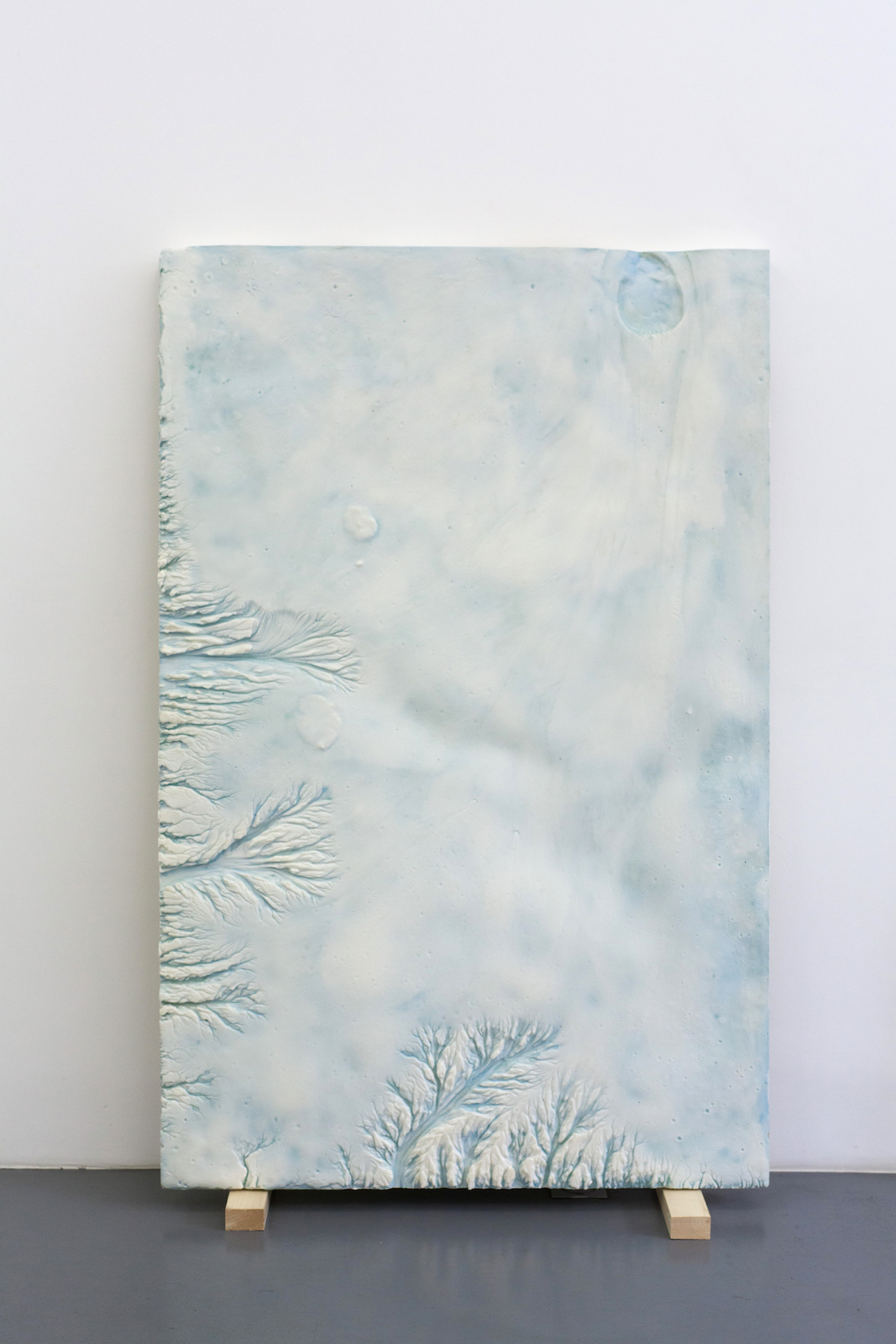
Polyurethane resin, P.U foam, Acrylic paint
57,9 x 36,9 x 3,5 inch
This resin casting is the result of the slow pouring of water through a bed of silica and present the frozen image of a liquid continuum. The subtle forms as much as the traced lines seem to be the emanation of an intelligence of water, a deep network of neurons, a self-generated sculpture which responds to it own logic. Equally taking interest in the miniature and the maquette, this work pursues research initiated in older works such as États Inversées (Inverted States) or Inframince Mont-Blanc (Mont-Blanc Infrathin).

Image: 60 x 71,5 cm
L'Ange de Nagasaki is a photography of the statue damaged by the atomic bomb dropped on Nagasaki 9 August 1945. In the past it made up an integral part of the Urakami cathedral. This angelic face was offered as a symbol of peace by the Japanese government to UNESCO in 1976. It was subsequently placed in the institution's gardens in Paris. The original statue is therefore a document and a monument at once in that it was a direct witness to the atomic cataclysm and in the fact that the scars related to this event confer to it a powerful symbolic significance. A monument then which remembers itself.

4,6 x 5,5 x 1,8 inch
Kintsugi is a reconstitution of a statue damaged by the atomic bomb dropped on Nagasaki 9 August 1945. The truncated face of the Angel of Nagasaki is reconstituted here by the artist who presents the half of it that has been destroyed. Produced in a block of white marble, this missing piece potentially repairs the figure of the Angel; it is a spectral and celestial alter ego of the human figure.
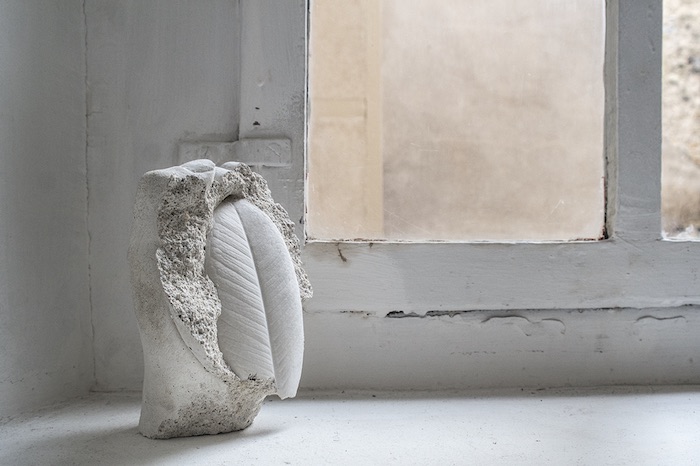
reconstituted stone
12 x 10 x 13 cm
©Augustin Dupuid
With these series of sculptures, Julien Discrit develops research where the materials and forms are intimately intertwined. He pursues two reflections very important in his work: one on the minerals, crystals and stones, and another on the spatial, geological and temporal relationship between humankind and its environment. Like future fossils, these sculptures of human hands holding rocks represent an almost archaic gesture of gripping. In a snapshot, they propose a "becoming stone" that plays with both materials - organic and mineral mixed together in yet another piece made of reconstituted stone - but also with artistic and historical practices in the sense of inventing a contemporary aesthetic from an artificial archaeological ruin. It thus reveals the aesthetic forms already given in our environment like these stones which are in themselves finished sculptural forms.

Reconstituted stone
5 x 5,3 x 4,1 inch
Dated and signed
With these series of sculptures, Julien Discrit develops research where the materials and forms are intimately intertwined. He pursues two reflections very important in his work: one on the minerals, crystals and stones, and another on the spatial, geological and temporal relationship between humankind and its environment. Like future fossils, these sculptures of human hands holding rocks represent an almost archaic gesture of gripping. In a snapshot, they propose a "becoming stone" that plays with both materials - organic and mineral mixed together in yet another piece made of reconstituted stone - but also with artistic and historical practices in the sense of inventing a contemporary aesthetic from an artificial archaeological ruin. It thus reveals the aesthetic forms already given in our environment like these stones which are in themselves finished sculptural forms.
- Le discret et le continu, Galerie Anne-Sarah Bénichou, Paris, France, 2018
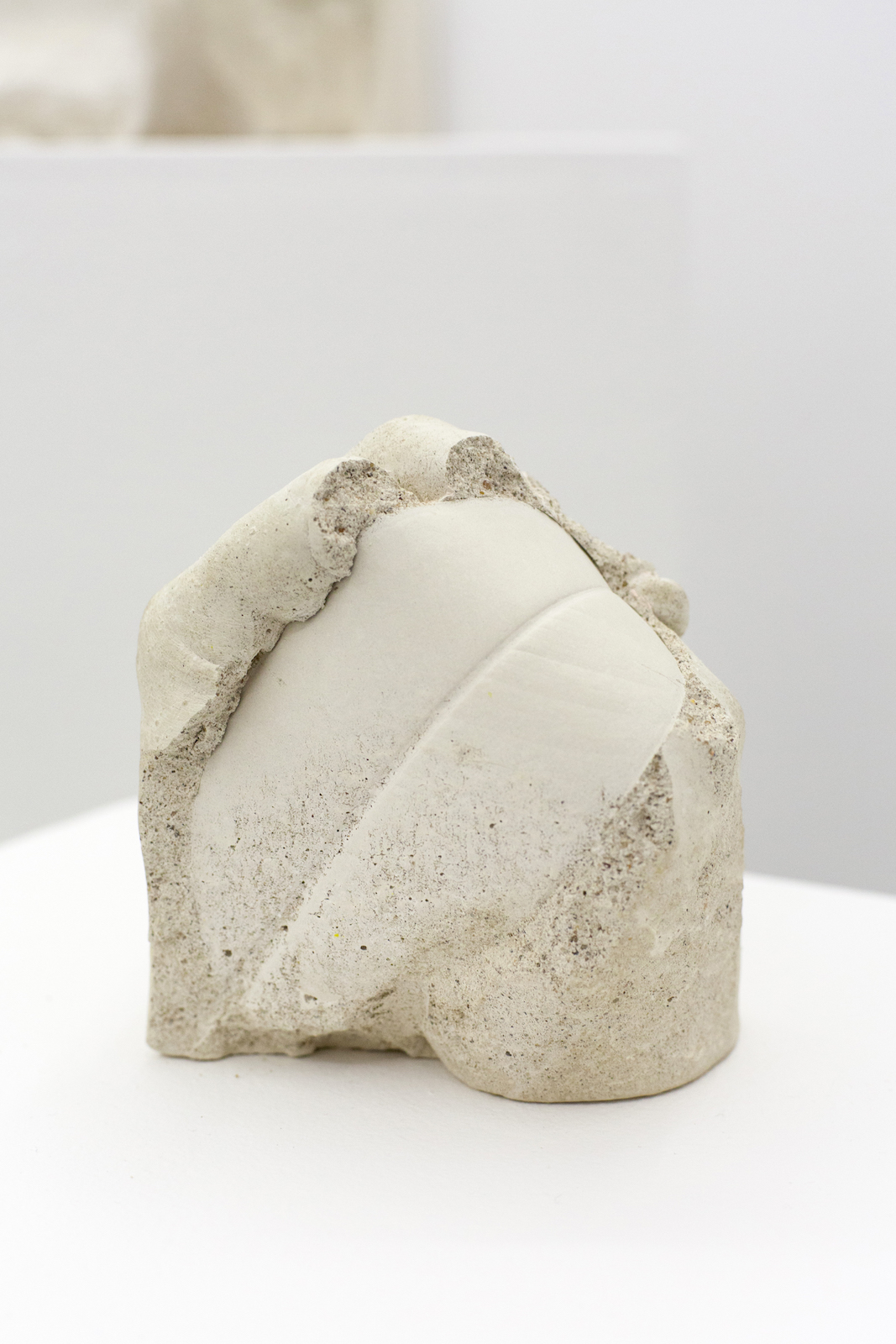
Reconstituted stone
5,5 x 4,7 x 4,3 inch
With these series of sculptures, Julien Discrit develops research where the materials and forms are intimately intertwined. He pursues two reflections very important in his work: one on the minerals, crystals and stones, and another on the spatial, geological and temporal relationship between humankind and its environment. Like future fossils, these sculptures of human hands holding rocks represent an almost archaic gesture of gripping. In a snapshot, they propose a "becoming stone" that plays with both materials - organic and mineral mixed together in yet another piece made of reconstituted stone - but also with artistic and historical practices in the sense of inventing a contemporary aesthetic from an artificial archaeological ruin. It thus reveals the aesthetic forms already given in our environment like these stones which are in themselves finished sculptural forms.
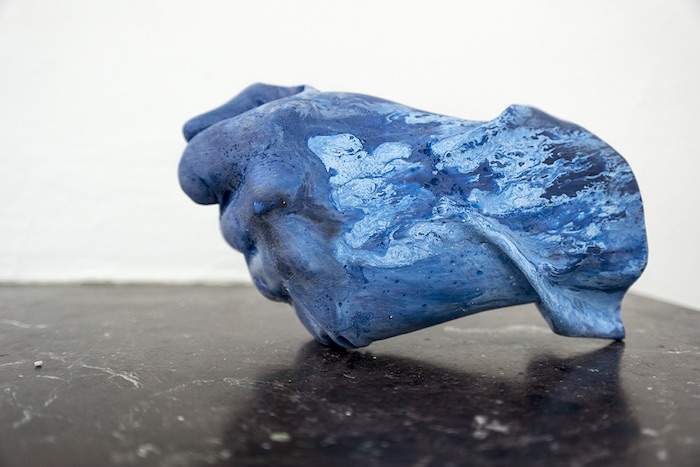
P.U resin, colorants
3,9 x 6,3 x 1,6 inch
©Augustin Dupuid
With these series of sculptures, Julien Discrit develops research where the materials and forms are intimately intertwined. He pursues two reflections very important in his work: one on the minerals, crystals and stones, and another on the spatial, geological and temporal relationship between humankind and its environment. Like future fossils, these sculptures of human hands holding rocks represent an almost archaic gesture of gripping. In a snapshot, they propose a "becoming stone" that plays with both materials - organic and mineral mixed together in yet another piece made of reconstituted stone - but also with artistic and historical practices in the sense of inventing a contemporary aesthetic from an artificial archaeological ruin. It thus reveals the aesthetic forms already given in our environment like these stones which are in themselves finished sculptural forms.

Reconstituted stone, rock
4 x 5,9 x 5,1 inch
With these series of sculptures, Julien Discrit develops research where the materials and forms are intimately intertwined. He pursues two reflections very important in his work: one on the minerals, crystals and stones, and another on the spatial, geological and temporal relationship between humankind and its environment. Like future fossils, these sculptures of human hands holding rocks represent an almost archaic gesture of gripping. In a snapshot, they propose a "becoming stone" that plays with both materials - organic and mineral mixed together in yet another piece made of reconstituted stone - but also with artistic and historical practices in the sense of inventing a contemporary aesthetic from an artificial archaeological ruin. It thus reveals the aesthetic forms already given in our environment like these stones which are in themselves finished sculptural forms.

reconstituted stone, rock
6,7 x 5,5 x 1,9 inch
©Augustin Dupuid
With these series of sculptures, Julien Discrit develops research where the materials and forms are intimately intertwined. He pursues two reflections very important in his work: one on the minerals, crystals and stones, and another on the spatial, geological and temporal relationship between humankind and its environment. Like future fossils, these sculptures of human hands holding rocks represent an almost archaic gesture of gripping. In a snapshot, they propose a "becoming stone" that plays with both materials - organic and mineral mixed together in yet another piece made of reconstituted stone - but also with artistic and historical practices in the sense of inventing a contemporary aesthetic from an artificial archaeological ruin. It thus reveals the aesthetic forms already given in our environment like these stones which are in themselves finished sculptural forms.

Reconstituted stone, polyurethane resin
9 x 19,5 x 11 cm
With these series of sculptures, Julien Discrit develops research where the materials and forms are intimately intertwined. He pursues two reflections very important in his work: one on the minerals, crystals and stones, and another on the spatial, geological and temporal relationship between humankind and its environment. Like future fossils, these sculptures of human hands holding rocks represent an almost archaic gesture of gripping. In a snapshot, they propose a "becoming stone" that plays with both materials - organic and mineral mixed together in yet another piece made of reconstituted stone - but also with artistic and historical practices in the sense of inventing a contemporary aesthetic from an artificial archaeological ruin. It thus reveals the aesthetic forms already given in our environment like these stones which are in themselves finished sculptural forms.
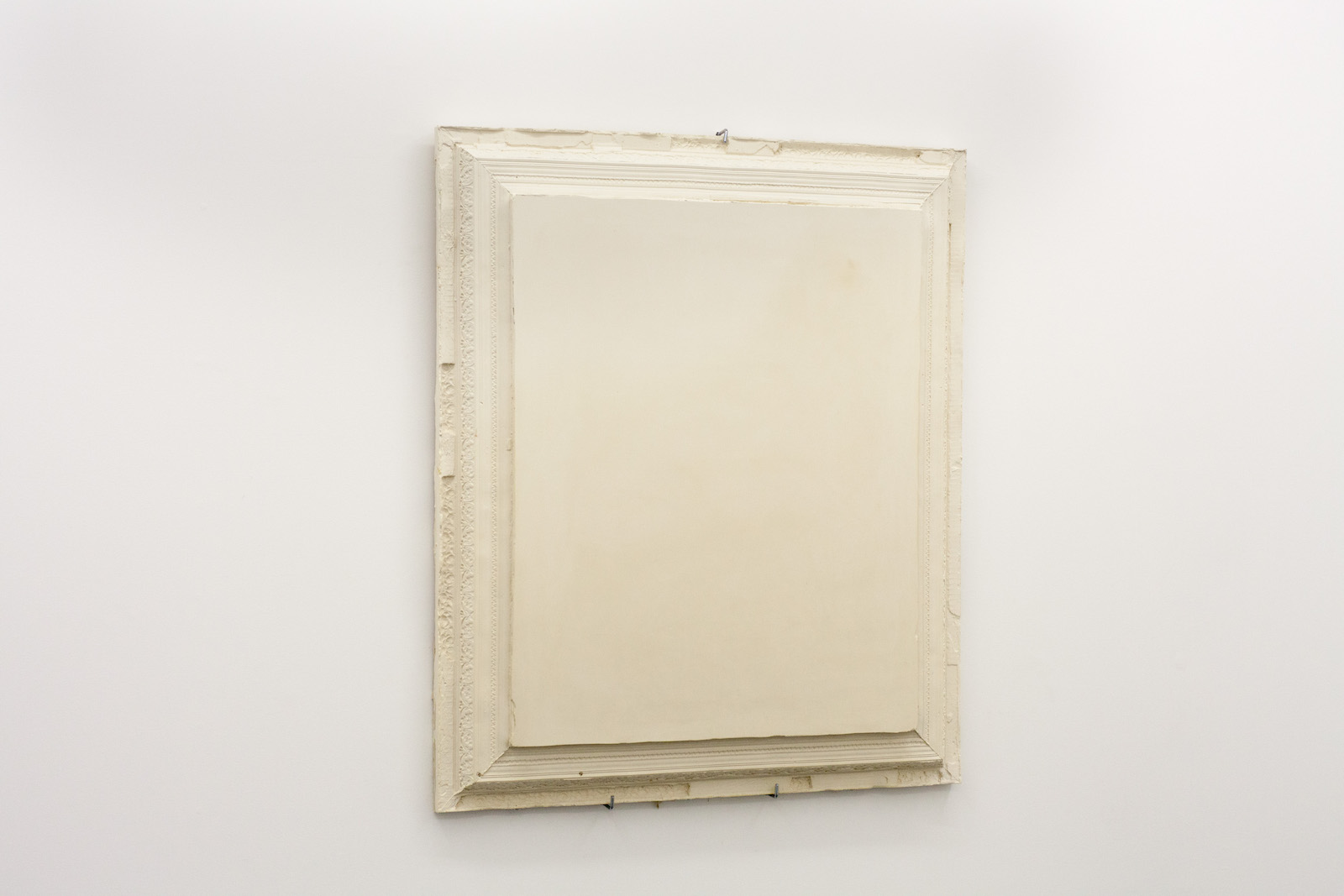
44,5 x 37,2 x 3,7 inch
This artwork is the moulding of a mirror, in its frame as a reflective surface. By apprehending this object in its entirety, it becomes an attempt to imprint a reflection.
Testimony of the inability to transcribe this phenomena, the artwork emphasizes on the essence which is the non-existent, the emptiness, the impossible.

Image: 2,6 x 4 inch
Mu echoes the fallen angel of Nagasaki (which constitutes an other artwork from the artist), as it shows the deserted form of an animal already gone: not a ghost, just an envelope. This cicada sloughing in a macroscopic view reveals its inanimate character through the transparency of its previous skin, like a dead body, as a continuity which dissolves or reconstructs itself.
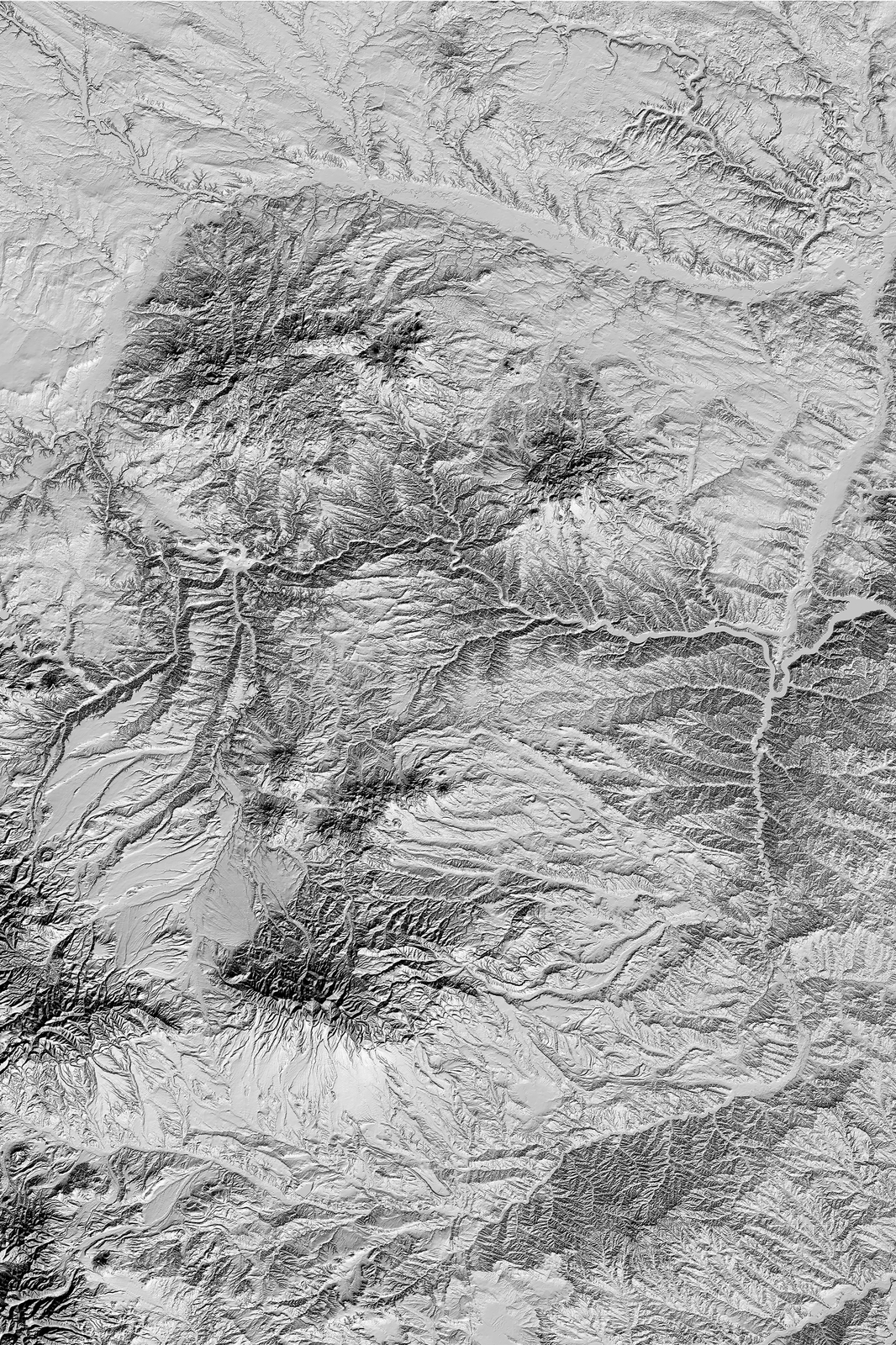
Image: 177,5 x 119 cm
Frame: 188,5 x 130 cm
États-inversés series have been created thanks to elevation data files and show monochromatic landscapes, rivers and mountains from the United States territory. Unless here after changing the light direction and so relief shading, the artist created an inverted landscape. Valleys became crests and mountains became depressions. So instead of offering the classic bird-eye view these maps gives us an exclusive view from underneath.
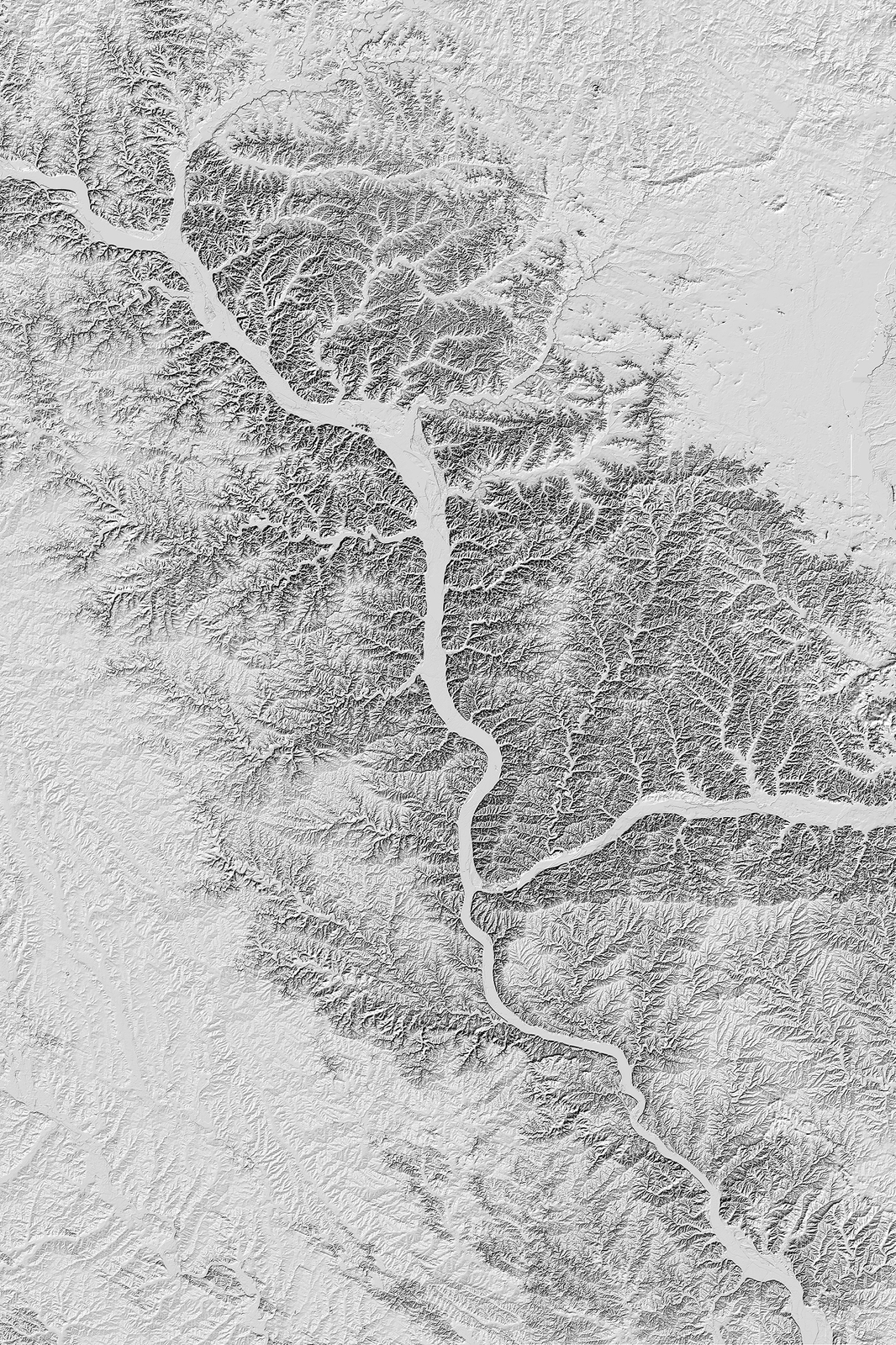
Image: 69,8 x 46,8 inch
Frame: 74,2 x 52 inch
Inverted Sates series have been created thanks to elevation data files and show monochromatic landscapes, rivers and mountains from the United States territory. Unless here after changing the light direction and so relief shading, the artist created an inverted landscape. Valleys became crests and mountains became depressions. So instead of offering the classic bird-eye view these maps gives us an exclusive view from underneath.
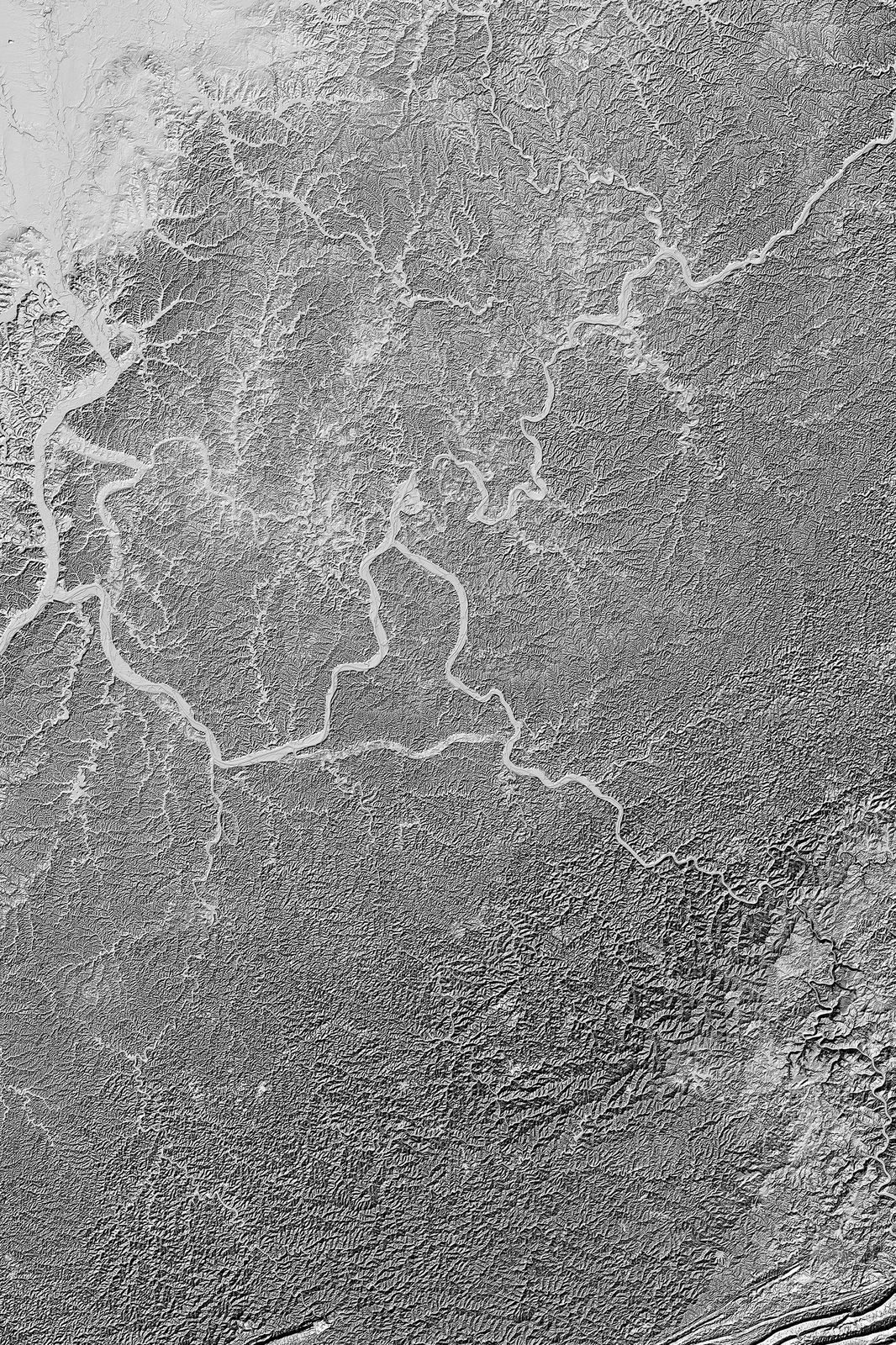
Image: 69,8 x 46,8 inch
Frame: 74,2 x 52 inch
Inverted Sates series have been created thanks to elevation data files and show monochromatic landscapes, rivers and mountains from the United States territory. Unless here after changing the light direction and so relief shading, the artist created an inverted landscape. Valleys became crests and mountains became depressions. So instead of offering the classic bird-eye view these maps gives us an exclusive view from underneath.
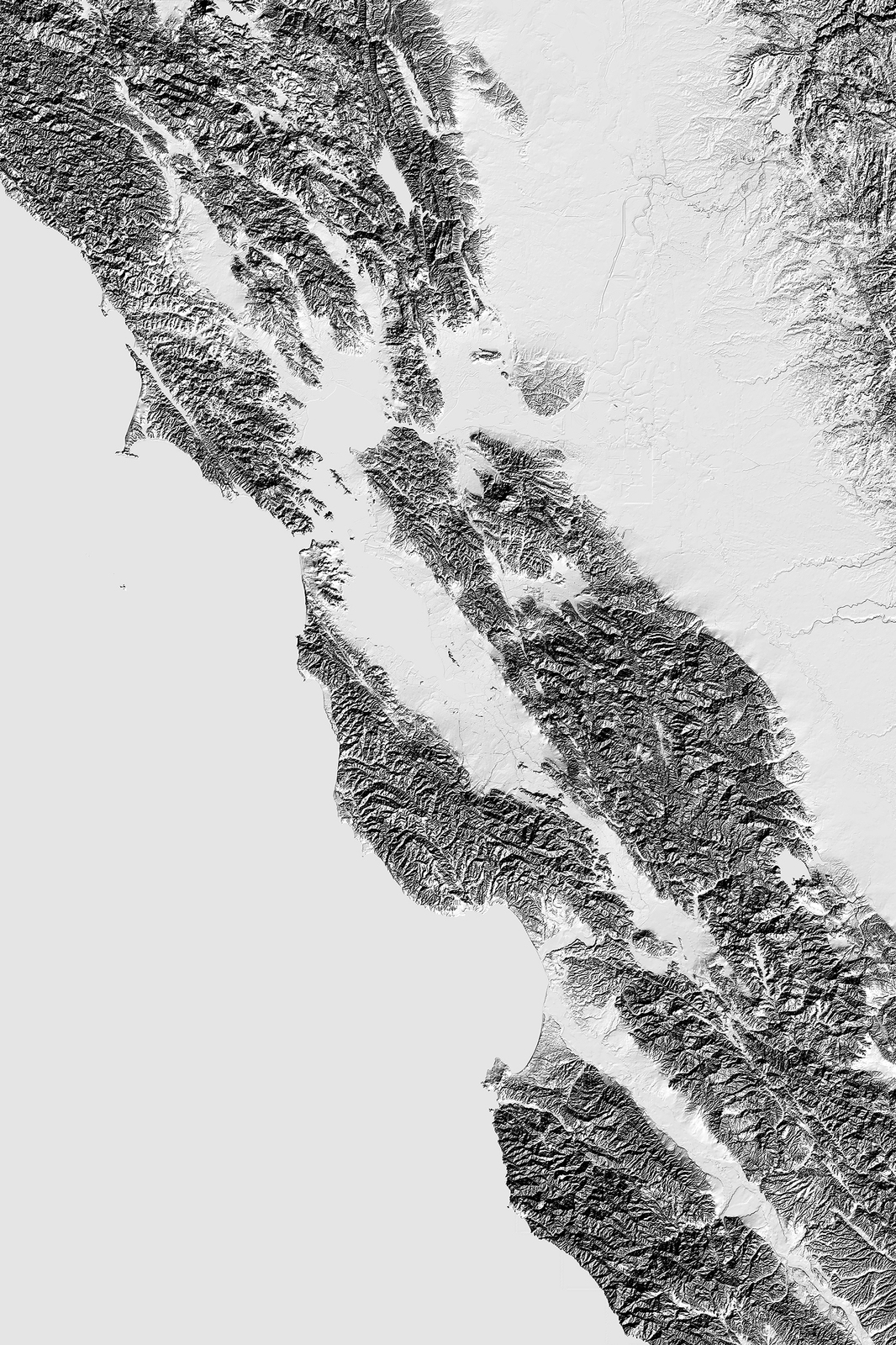
Image: 177,5 x 119 cm
Frame: 188,5 x 130 cm
The États-inversés series was initiated in 2010 by Julien Discrit. Based on a division of American geography, the artist reinterprets the process of shading in cartography, which consists of highlighting variations in terrain by reproducing fictitious sunlight on the slopes and thus producing a two-dimensional impression of relief. By inverting the conventionally used spectrum and turning these maps into black and white, Julien Discrit creates a new way of apprehending relief. He thus reverses the reading of the American territory, creating new motifs from a pre-existing mode of representation.
In the first instance, he produced a complete atlas of the American relief in two volumes. In a second phase, in 2016, he decided to make prints of some of the cities in the book by reproducing them in large format. In doing so, he added a new dimension to the work by integrating the idea of scale, which disrupts our representation of spaces and questions our ways of making the world around us intelligible.

Image: 80 x 63,9 cm
N38W084 highlights patterns from topographic surveys, here those of a vast american territory. In the continuity of the Mille Mississipi series, the processing of the figures obtained and the work of color reveal a multitude of hydrographic networks of streams, rivers, metaphors or pretexts to dream in front of figures that become trees, neurological connections, plants or electrical forms...
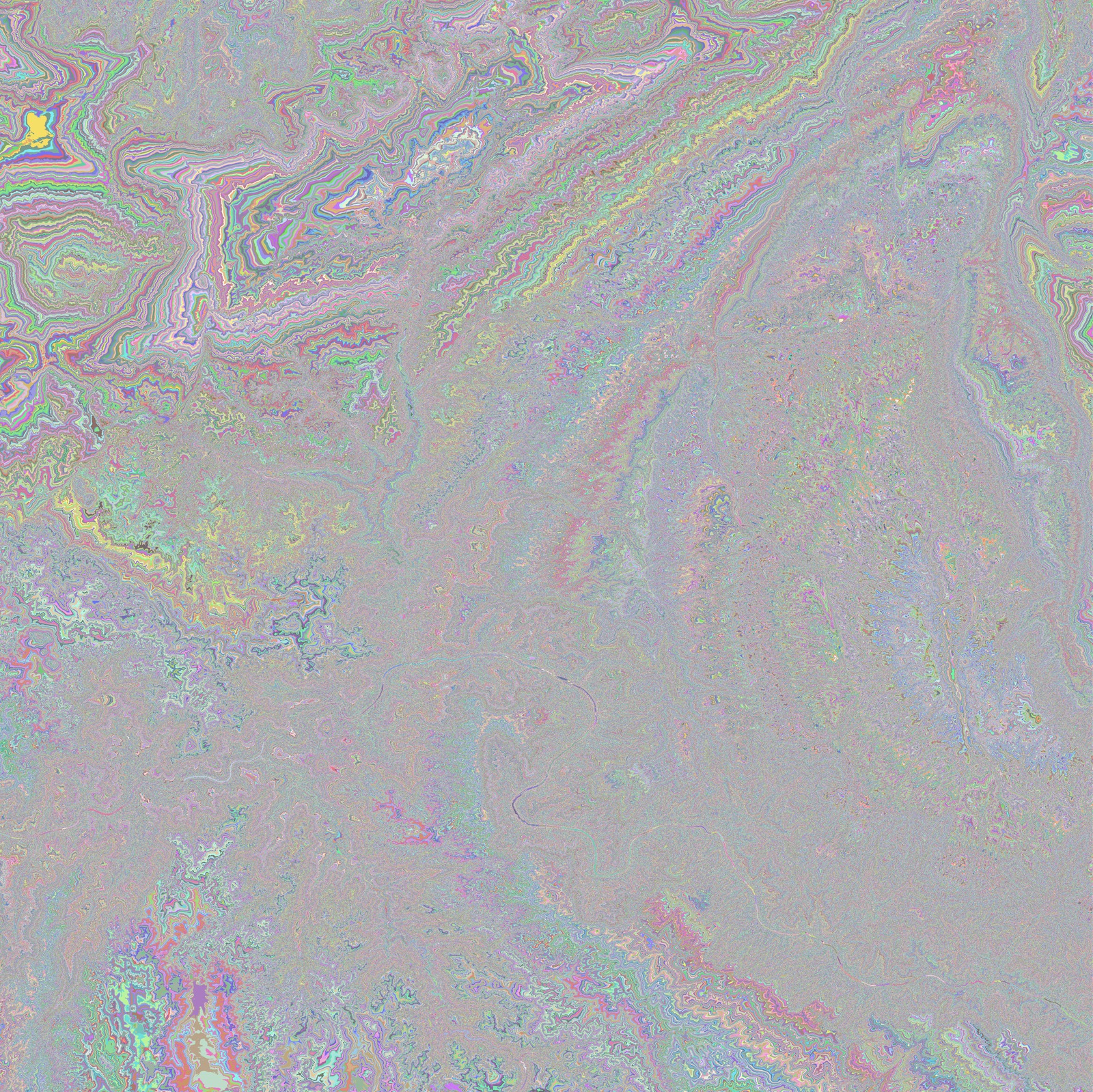
Image: 59 x 59 inches
This work takes as its starting point elevation data, that is to say terrain surveys, topographic surveys... The image is processed by fine color variations, depending on the altitude (colors vary every 30 cm of elevation). This image shows an area of the Grand Canyon whose particularity is the great variety of rock layers and reliefs. The image thus obtained creates a sort of palimpsest of volutes of all the reliefs of the Grand Canyon over a few thousand years.
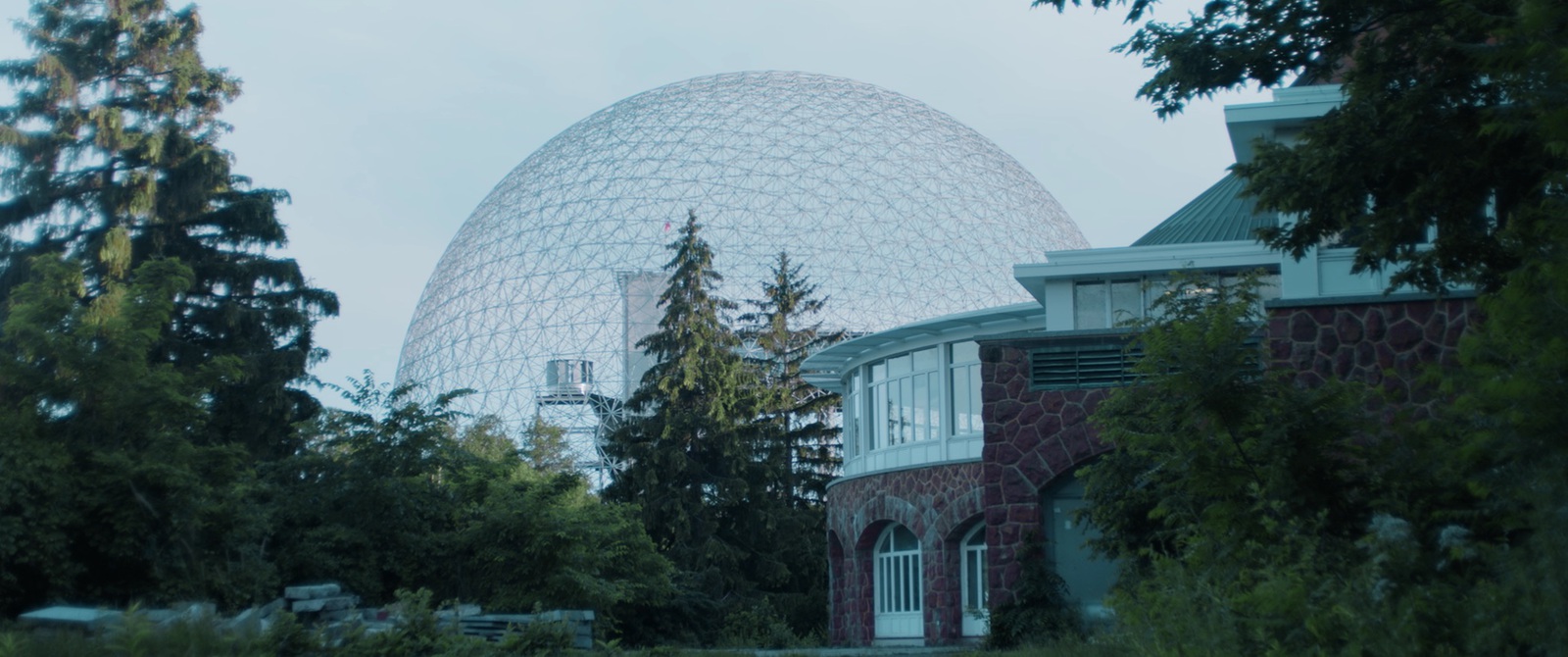
10'47''
67/76 takes as subject and decor the former site of the 1967 Universal exposition, which took place in Montreal (Canada). The Expo 67, named "Man and his World", spanned two highlands specially built for the occasion, located in the middle of Saint-Laurent river.
The film presents the vestiges of this event, whose the dome designed by Buckminster Fuller is certainly remains the most emblematic legacy.
Oeuvre produite avec le soutien de la FNAGP
Avec le soutien à une recherche/production artistique du CNAP
Ce projet bénéficie du soutien de Lafayette Anticipations - Fonds de dotation Famille Moulin, Paris
Collection of Institut d'Art Contemporain, Rhône-Alpes.

10'47''
67/76 takes as subject and decor the former site of the 1967 Universal exposition, which took place in Montreal (Canada). The Expo 67, named "Man and his World", spanned two highlands specially built for the occasion, located in the middle of Saint-Laurent river.
The film presents the vestiges of this event, whose the dome designed by Buckminster Fuller is certainly remains the most emblematic legacy.
Oeuvre produite avec le soutien de la FNAGP
Avec le soutien à une recherche/production artistique du CNAP
Ce projet bénéficie du soutien de Lafayette Anticipations - Fonds de dotation Famille Moulin, Paris
Collection of Institut d'Art Contemporain, Rhône-Alpes.

10'47''
67/76 takes as subject and decor the former site of the 1967 Universal exposition, which took place in Montreal (Canada). The Expo 67, named "Man and his World", spanned two highlands specially built for the occasion, located in the middle of Saint-Laurent river.
The film presents the vestiges of this event, whose the dome designed by Buckminster Fuller is certainly remains the most emblematic legacy.
Oeuvre produite avec le soutien de la FNAGP
Avec le soutien à une recherche/production artistique du CNAP
Ce projet bénéficie du soutien de Lafayette Anticipations - Fonds de dotation Famille Moulin, Paris
Collection of Institut d'Art Contemporain, Rhône-Alpes.

10'47''
67/76 takes as subject and decor the former site of the 1967 Universal exposition, which took place in Montreal (Canada). The Expo 67, named "Man and his World", spanned two highlands specially built for the occasion, located in the middle of Saint-Laurent river.
The film presents the vestiges of this event, whose the dome designed by Buckminster Fuller is certainly remains the most emblematic legacy.
Oeuvre produite avec le soutien de la FNAGP
Avec le soutien à une recherche/production artistique du CNAP
Ce projet bénéficie du soutien de Lafayette Anticipations - Fonds de dotation Famille Moulin, Paris
Collection of Institut d'Art Contemporain, Rhône-Alpes.
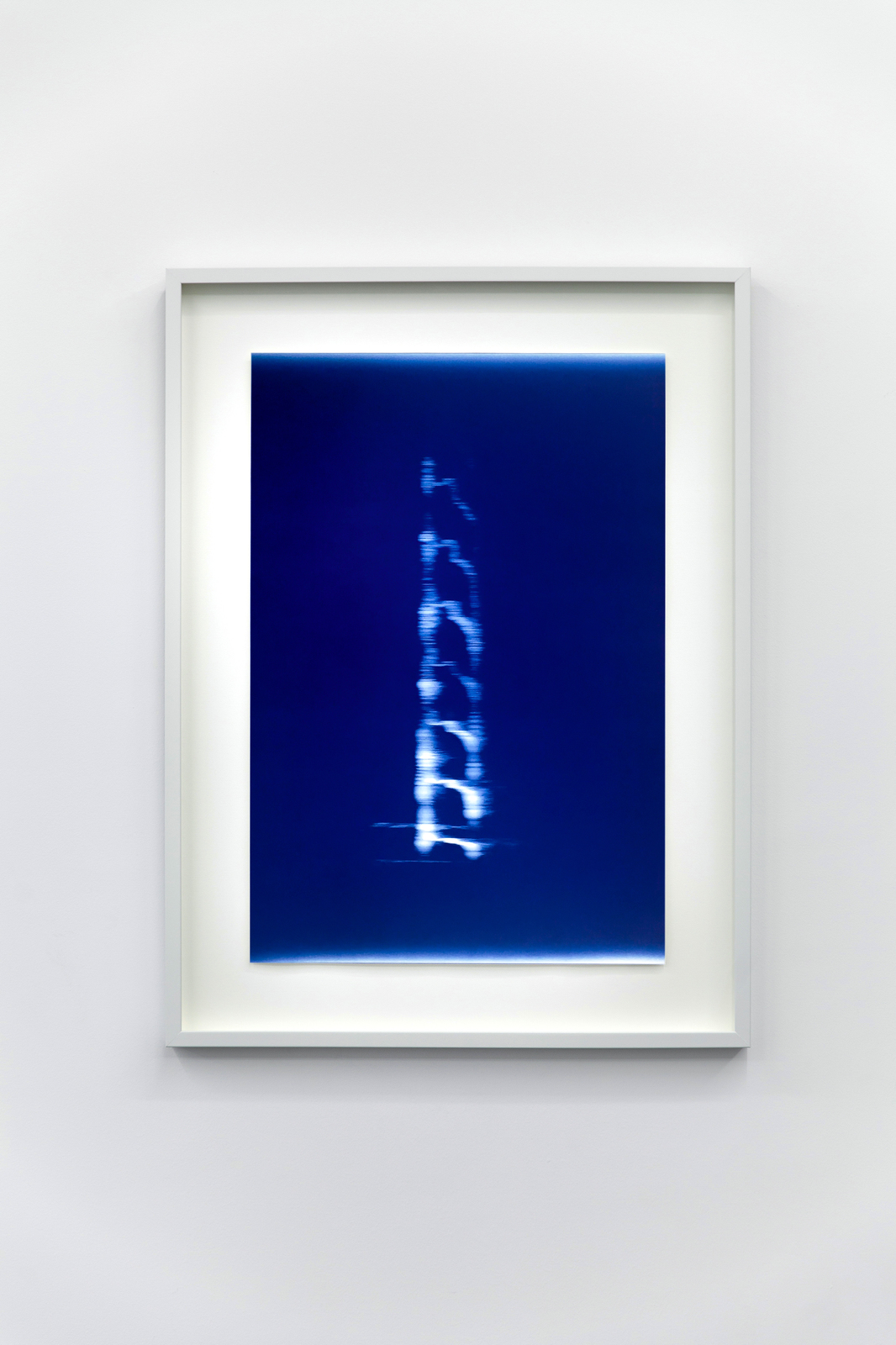
Cyanotype on paper
23,2 x 15,7 inches
Black woodpecker song uses a photographic process that leads to the origins of photography. The cyanotype shows the ephemeral and immaterial birds? chirping, in a graphic shape produced by sound analysis.
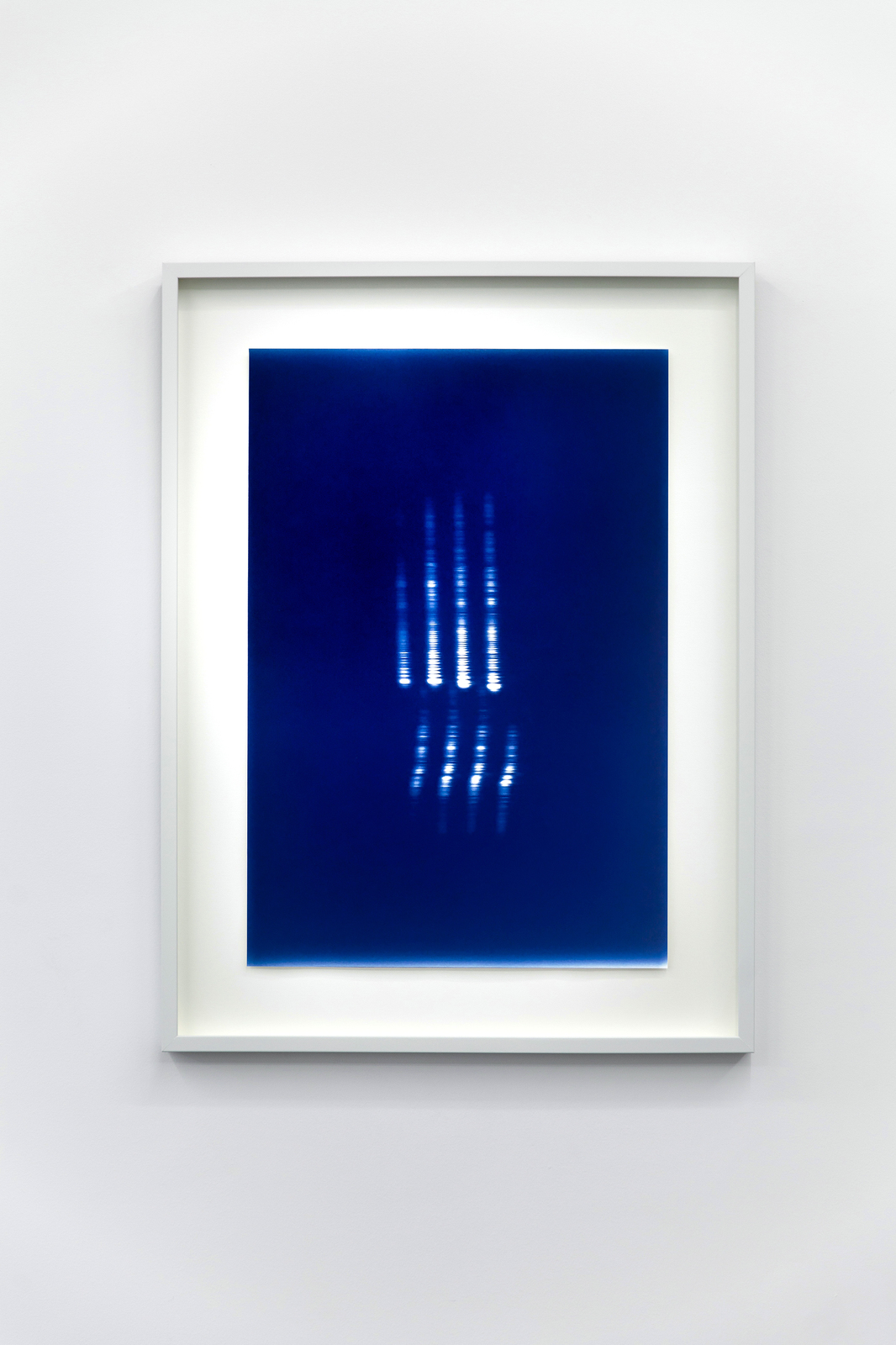
Cyanotype on paper
23,2 x 15,7 inches
Black tit song uses a photographic process that leads to the origins of photography. The cyanotype shows the ephemeral and immaterial birds? chirping, in a graphic shape produced by sound analysis.

Cyanotype on paper
23,2 x 15,7 inches
Exhibition :
- L'air vibre du bourdonnement des insectes, Musée départemental d'art contemporain de Rochechouart, 07th October - 17th December, Rochechouart, France

Cyanotype on paper
23,2 x 15,7 inches
Initiating a new body of works, Chant du merle noir uses a photographic process that leads to the origins of photography. The cyanotype shows the ephemeral and immaterial black bird chirping, in a graphic shape produced by sound analysis.
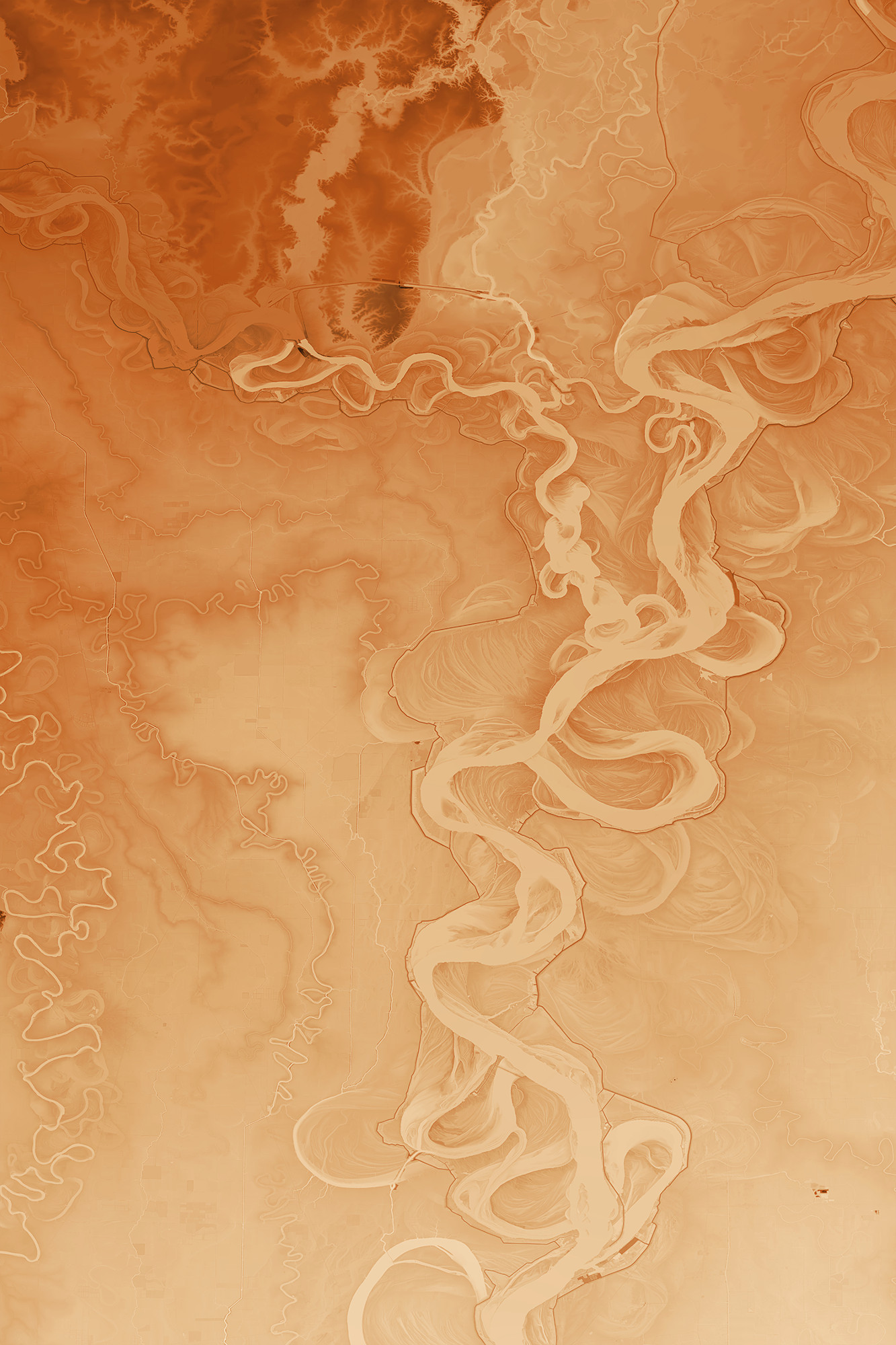
Image: 35,4 x 23,6 in
Frame: 36,2 x 24,4 x 1,6 in
A thousand Mississippi series is based on elevation datas, in other words topography. They show real areas of the Mississippi valley, from which we can observe the infinite curves and former bends. Thanks to a subtil color grading, the picture reveals the former paths of the river, engraved in the ground of the valley.
Exhibitions:
- Mapping at Last, Gallery Eric Mouchet, 04th febr- 25th march 2017, Paris, France
-Le Souvenir des pierres, Gallery Anne-Sarah Bénichou, 21 may -23 july 2016, Paris, France
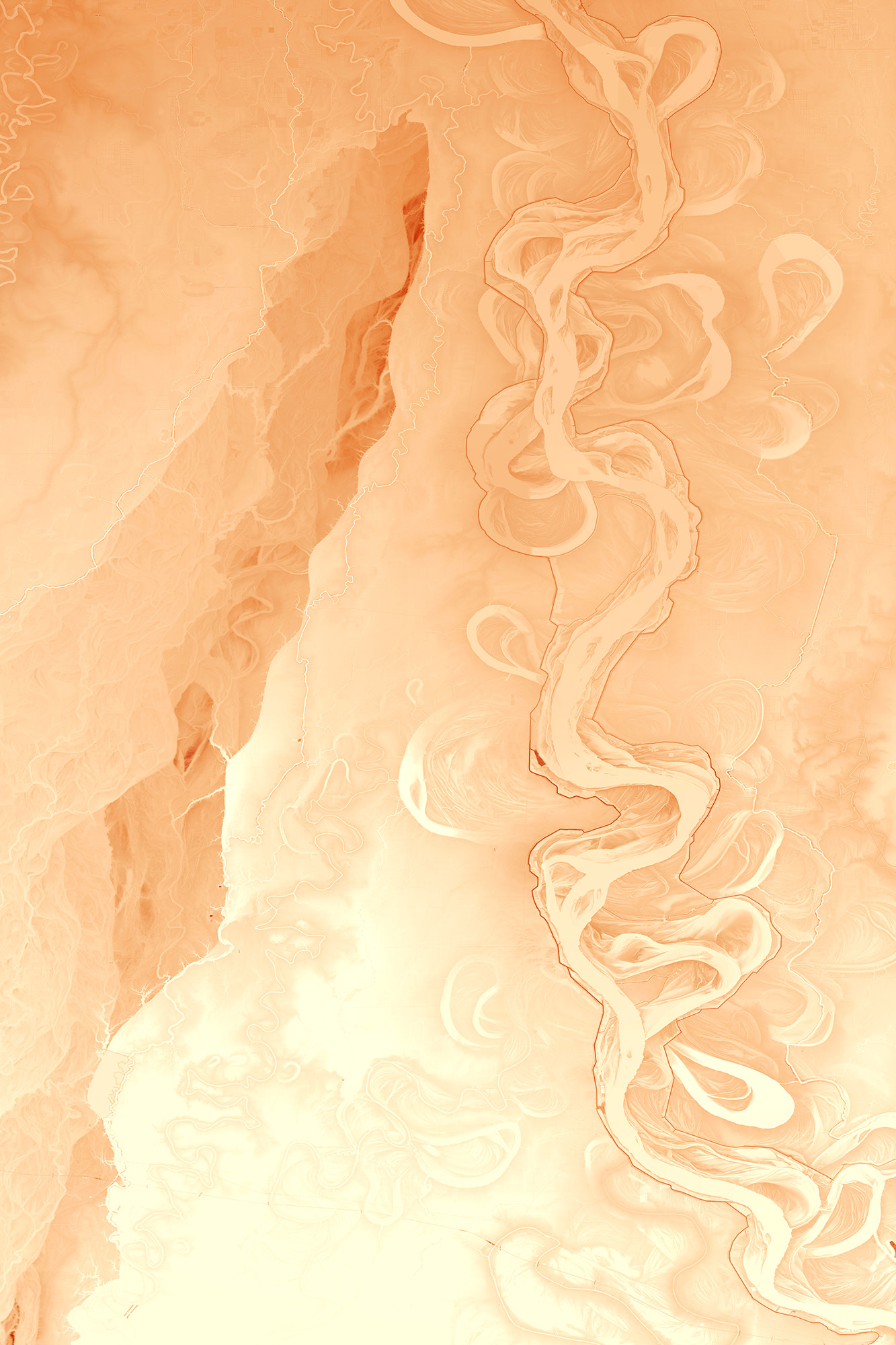
Image: 35,4 x 23,6 in
Frame: 36,2 x 24,4 x 1,6 in
A thousand Mississippi series is based on elevation datas, in other words topography. They show real areas of the Mississippi valley, from which we can observe the infinite curves and former bends. Thanks to a subtil color grading, the picture reveals the former paths of the river, engraved in the ground of the valley.
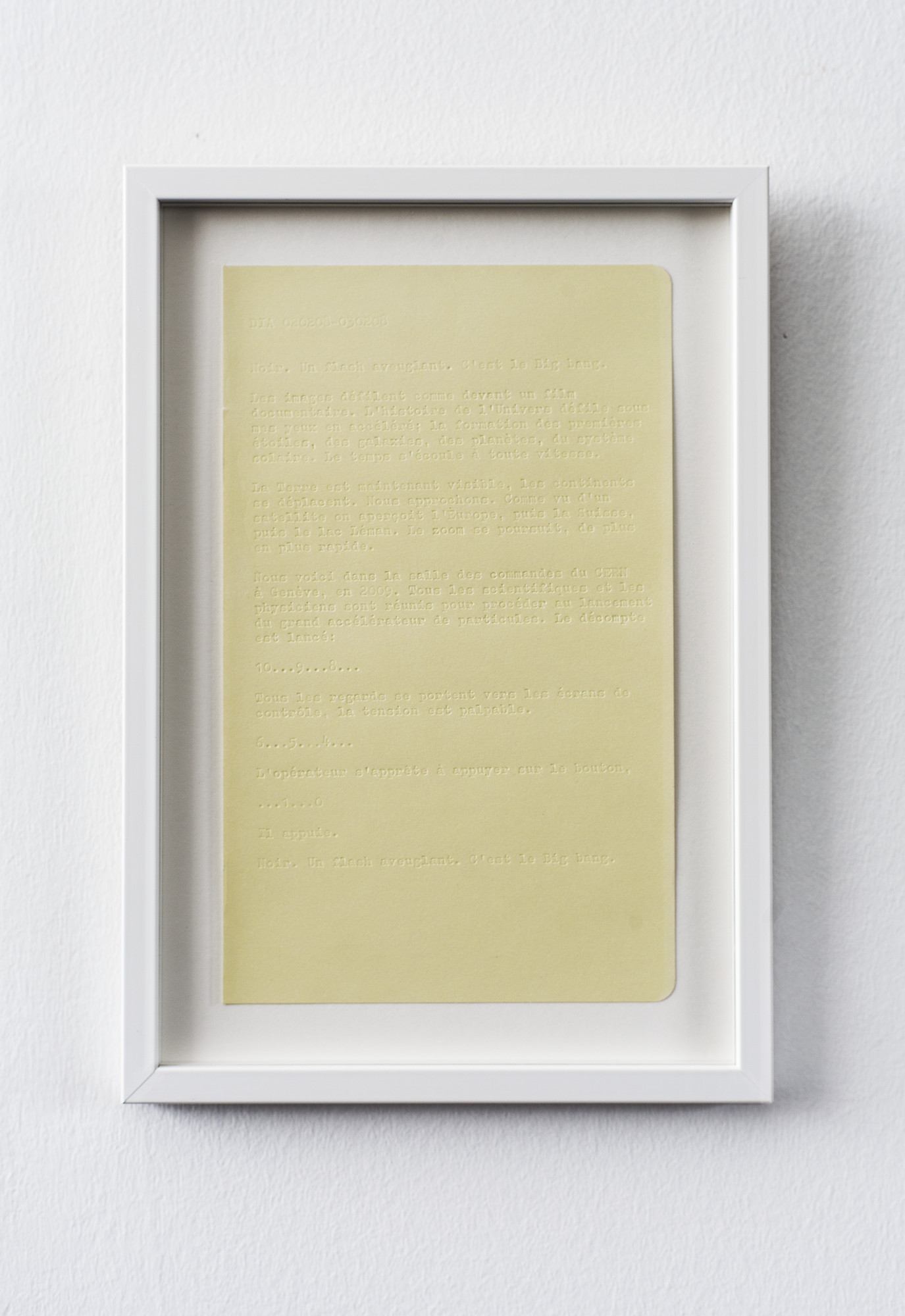
Embossed notebook page
7,9 x 4,9 in
Each Diagramme offers the story of a selected dream made by the artist, realised on a notebook page. By removing the ribbon from a typewriter, the paper has been carved to create the letters and the words which make these scripts visible for our eyes
Exhibition:
- Le souvenir des pierres, Galerie Anne-Sarah Bénichou, Paris, 21st May-16th july 2016
Diagramme n°071214-081214"Mont Viso"
Je marche sur un sentier de montagne avec un ami.
Notre objectif est d'atteindre le sommet du Mont Viso.
Au bout d'un moment nous arrivons enfin à la minuscule plate-forme qui constitue le sommet.
Nous nous reposons un instant pour profiter du panorama.
En voulant m'asseoir je fais basculer une grosse roche qui tombe sur le sol et se brise
immédiatement en deux, presque en son milieu.
Je me rends alors compte que sur une des deux faces mise à nu est inscrit quelque chose; un mot est gravé dans la pierre.
Je me demande comment ce mot a bien pu être gravé à l'intérieur de la roche.
Je m'approche pour pouvoir le déchiffrer, je n'arrive pas à le lire.
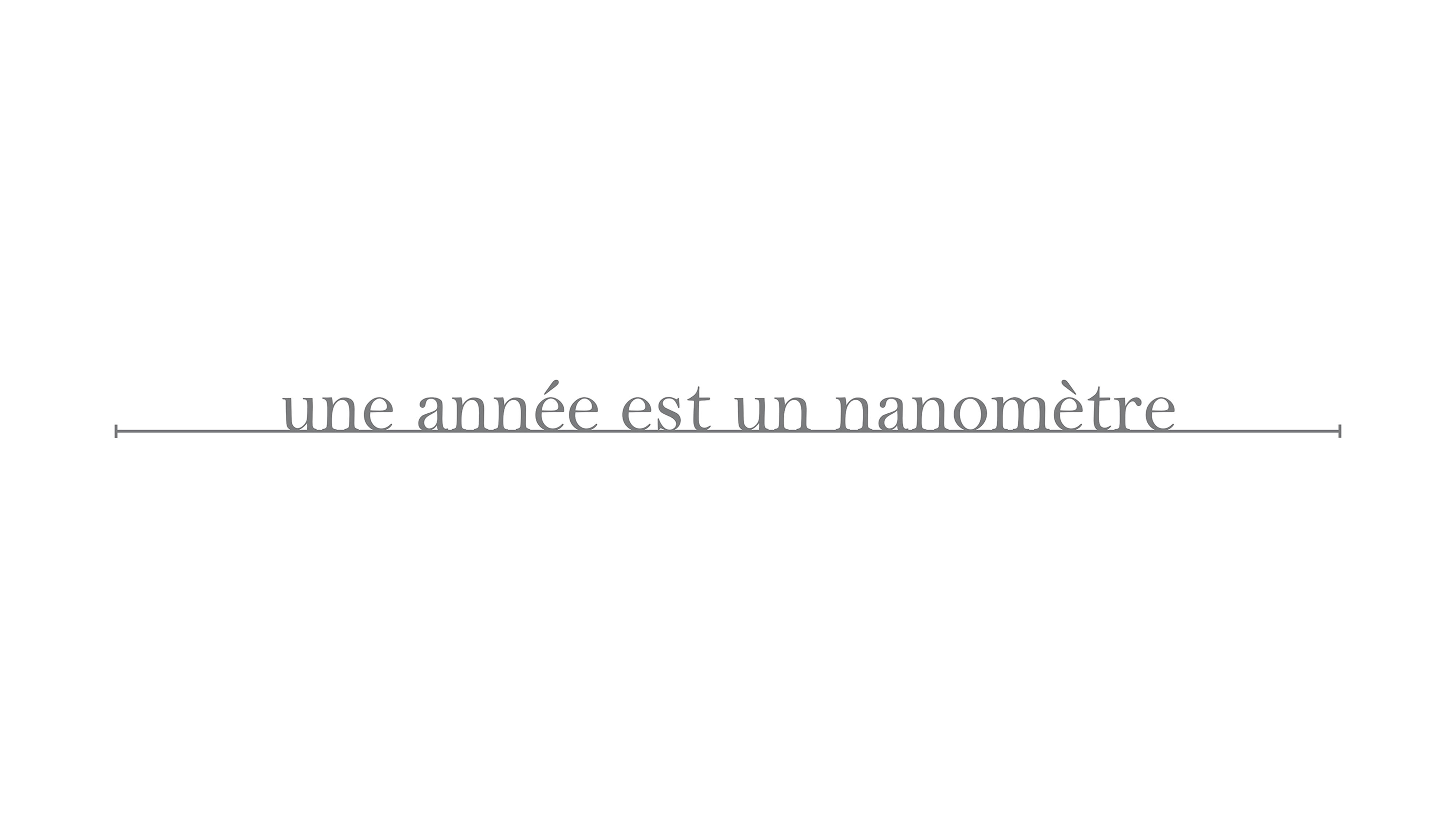
8,5 x 181,1 in
4.6 billion of years are materialized by an 4.6 meters line.
Once this scale ratio installed, it follows that one year equals one nanometer. We can also deduce that there are a billion of nanometers in one meter.

74,5 x 40,5 cm
Taking up the rules used in the building of Micronesian stick charts, Carte mémoire (Memory Card/Map) offers a primitive and personnal cartography of the city of Montreal. Built on an oversimplified pattern, with no respect of distance, it sets up a support to the memorization of space and it flows, representing the remembered spots as islands of an intimate achipelago.
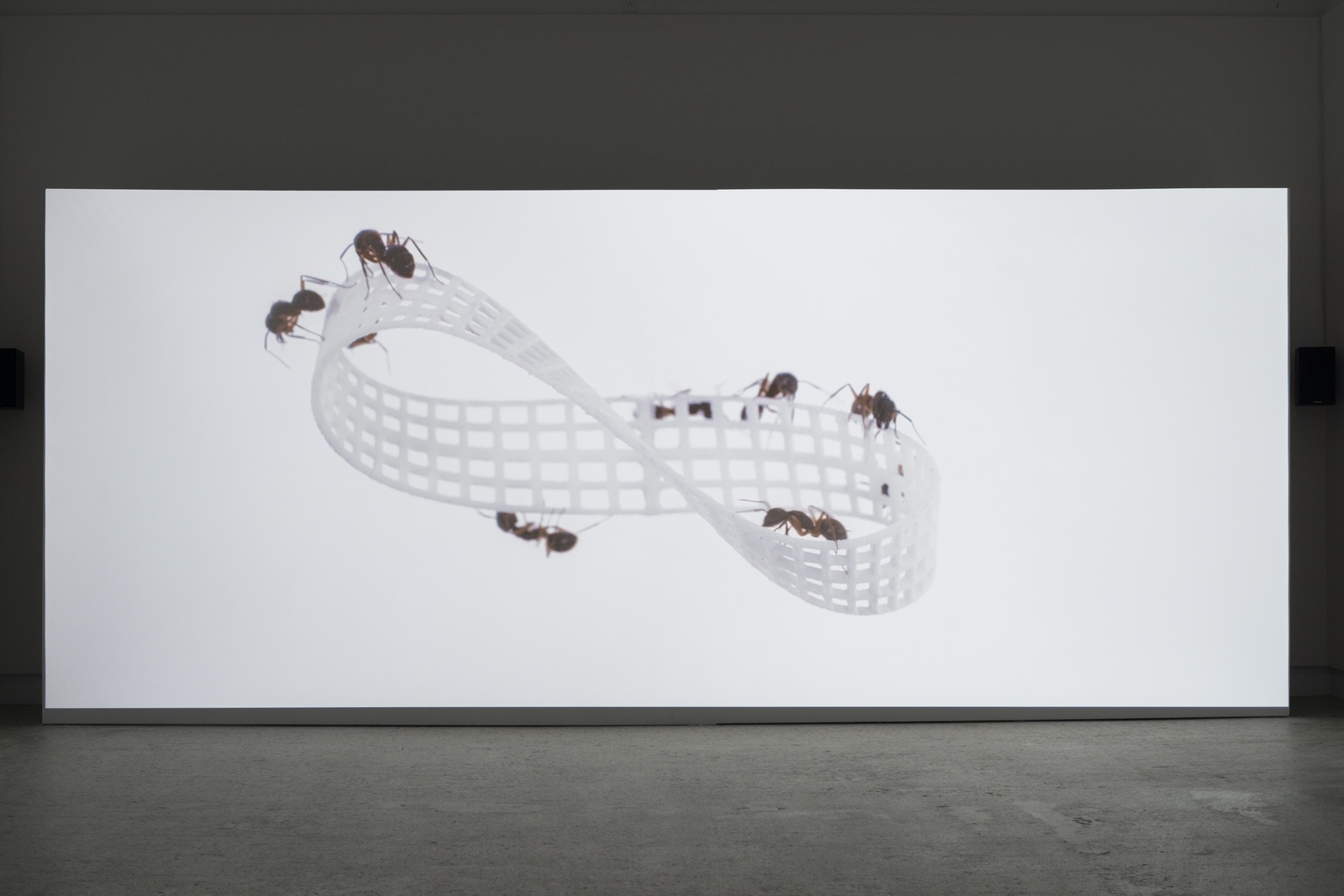
9'32
© Paul Litherland
While the strip remained an object of fascination for mathematicians throughout the 19th century, it was quickly taken up by some very influential thinkers in the human and social sciences. Lacanian psychoanalysis, for instance, uses the Möbius strip as a spatialization model for the work of the unconscious.
As for formal dimensions of Discrit's video, they refer to a series of drawings and woodcuts produced by M.C. Escher in the early 1960s depicting nine red ants crawling along a Möbius strip, usually placed vertically.?Following a precise contortion, the Möbius strip?which becomes a felt space in the video? reveals the cyclical relationship between the physical elaboration of a mathematical concept, its reuse in the social sciences, its potential artistic representations, and the experience it can afford as a physical phenomenon.
Daniel Fiset
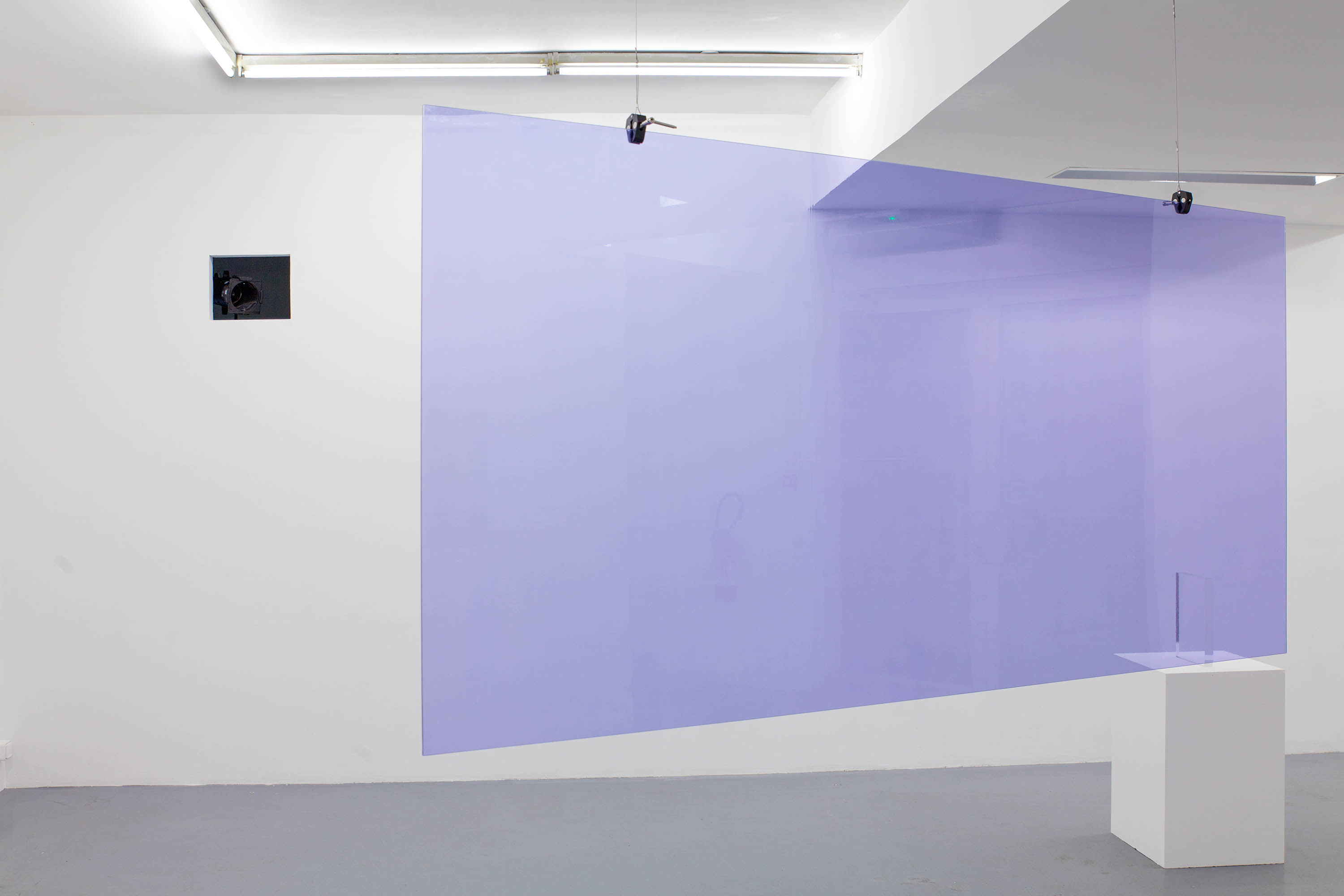
Variable dimensions
Décalques is an attempt to reproduce a moment. A spectrometer has been used to captured light, in a specific point in time and space. The installation (re) creates this moment, thanks to a combination of colour filters used in the cinema industry. Thus it can can be considered litteraly as a “photo-graph”. However here, there is no image, but only a colour impression from a moment in the past.

31,5 x 31,5 inches each
These maps representing French Guyana have been produced by the French national geographic institute. Surprisingly, in some areas the map shows lack of information where it is written 'nuages' (clouds). These blank spaces have been cut, as the inverted representation of the cumulus passing over the rain forest, the day the institute took aerial pictures.
Collection Frac Lorraine, Metz, France
Exhibitions:
- Le souvenir des pierres, Galerie Anne-Sarah Bénichou, Paris, 21st May-16th juiy 2016
- Territoire Hopi , Galerie YGREC, Paris, 4th December 2015- 23rd January 2016.
- La mesure du possible, Galerie Thomas Henry Ross. Montréal, Canada, 2nd-30th August 2014.
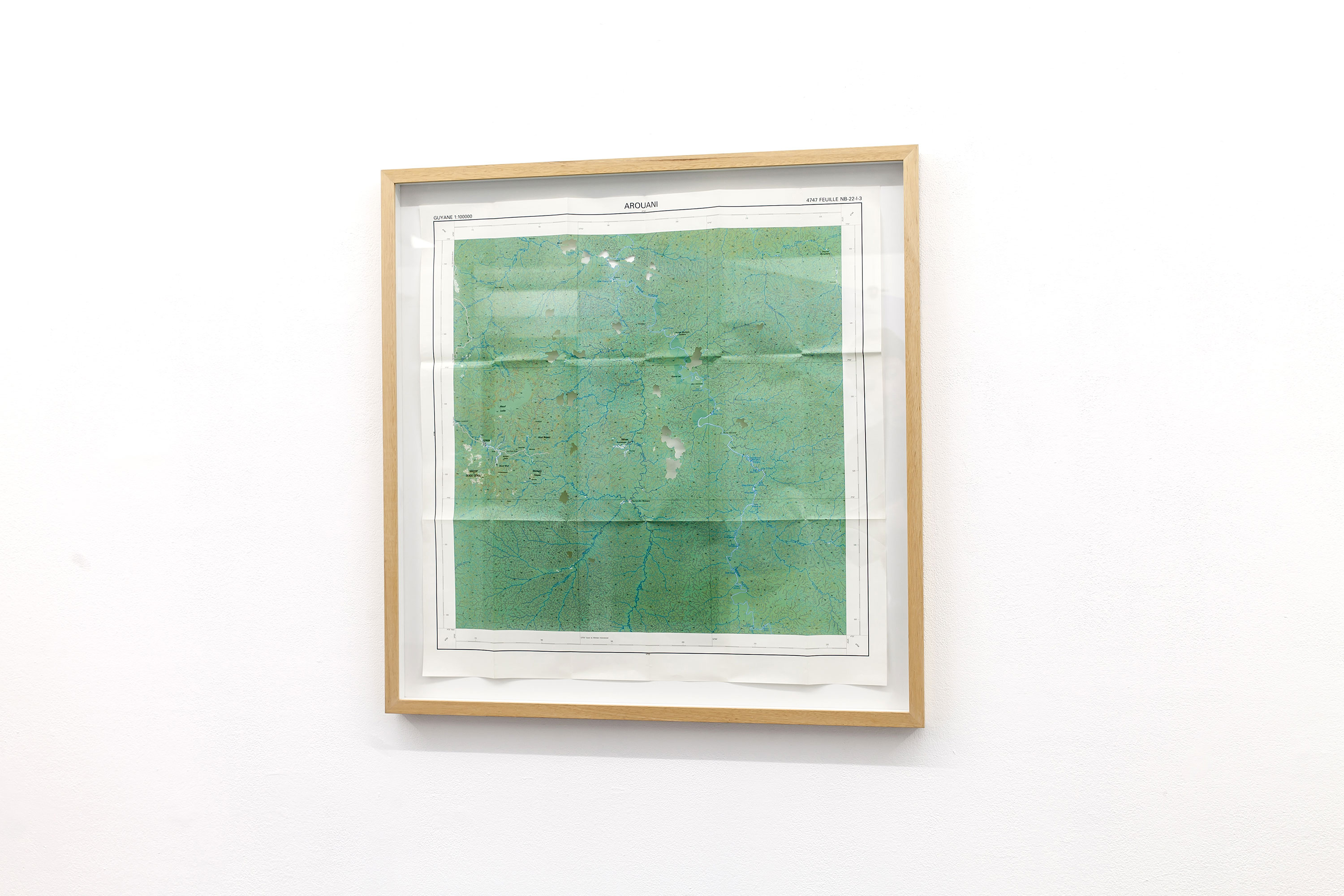
76,5 x 74,5 cm
These maps representing French Guyana have been produced by the French national geographic institute. In some areas the map shows lack of information where it is written 'nuages' (clouds). These blank spaces have been cut, as the inverted representation of the cumulus passing over the rain forest, the day the institute took aerial pictures.
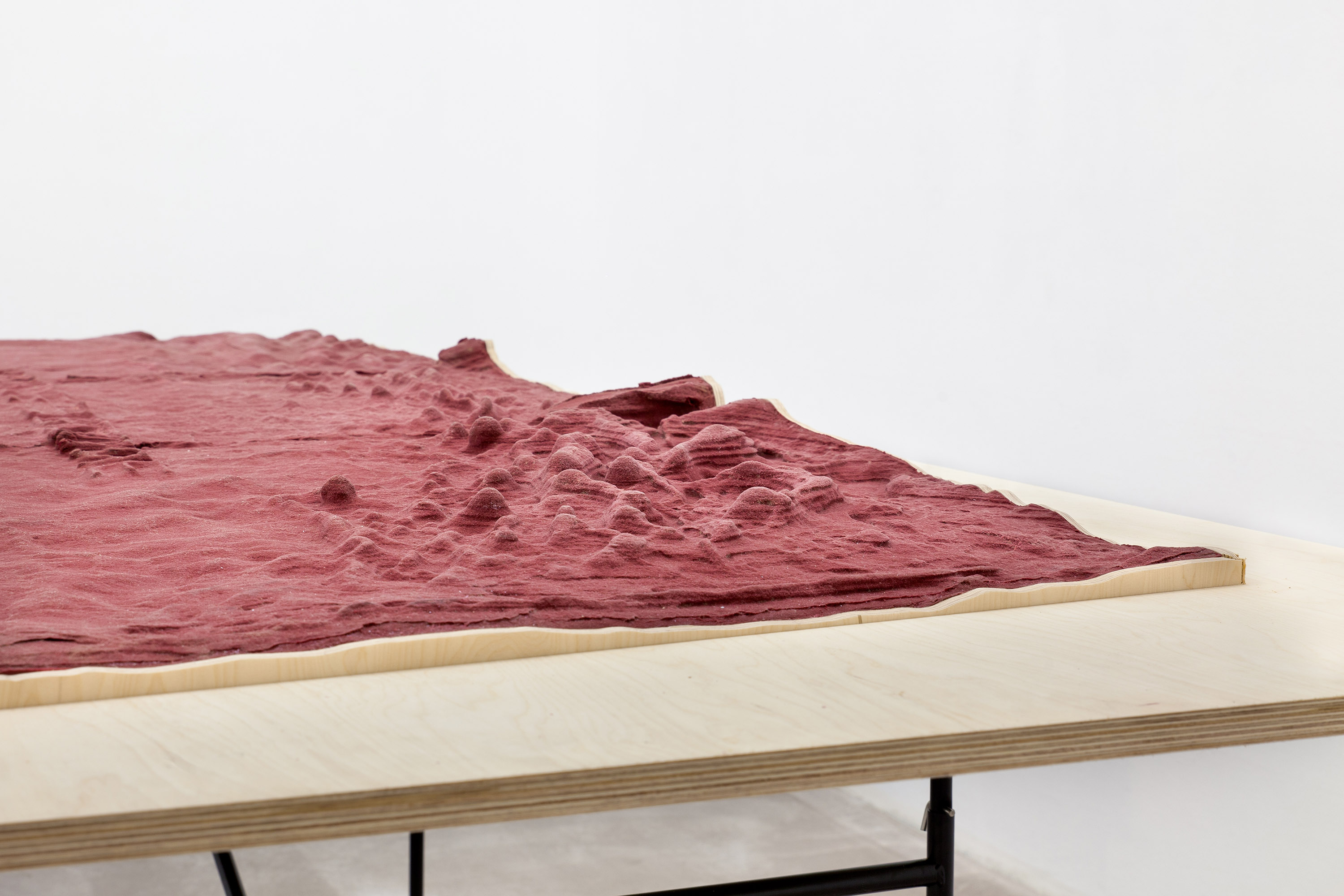
40,9 x 98,4 x 42,5 inches
Hopi territory is a silicone imprint of a wall, more precisely from a 150 years old building, located in the historic center of Montreal. This imprint is cast and then displayed horizontaly on a table. The original bas-relief, naturally created by years and years of erosion, becomes the model of an imaginary territory.

12,9 9,4 x 1,4 inches
Simply composed by a plexiglas block placed on a photograph, Ce qui nous regarde (literally “what stares at us or what is our concern”) is a piece with double meaning, as the display hides and reveals in the same time the image of a absent look.

Image: 34 x 27 x 5,5 cm (chaque)
These images have been created thanks to elevation data files and show monochromatic landscapes, rivers and mountains from the United States territory. Unless here after changing the light direction and so relief shading, the artist created an inverted landscape. Valleys became crests and mountains became depressions. So instead of offering the classic bird-eye view these maps gives us an exclusive view from underneath.
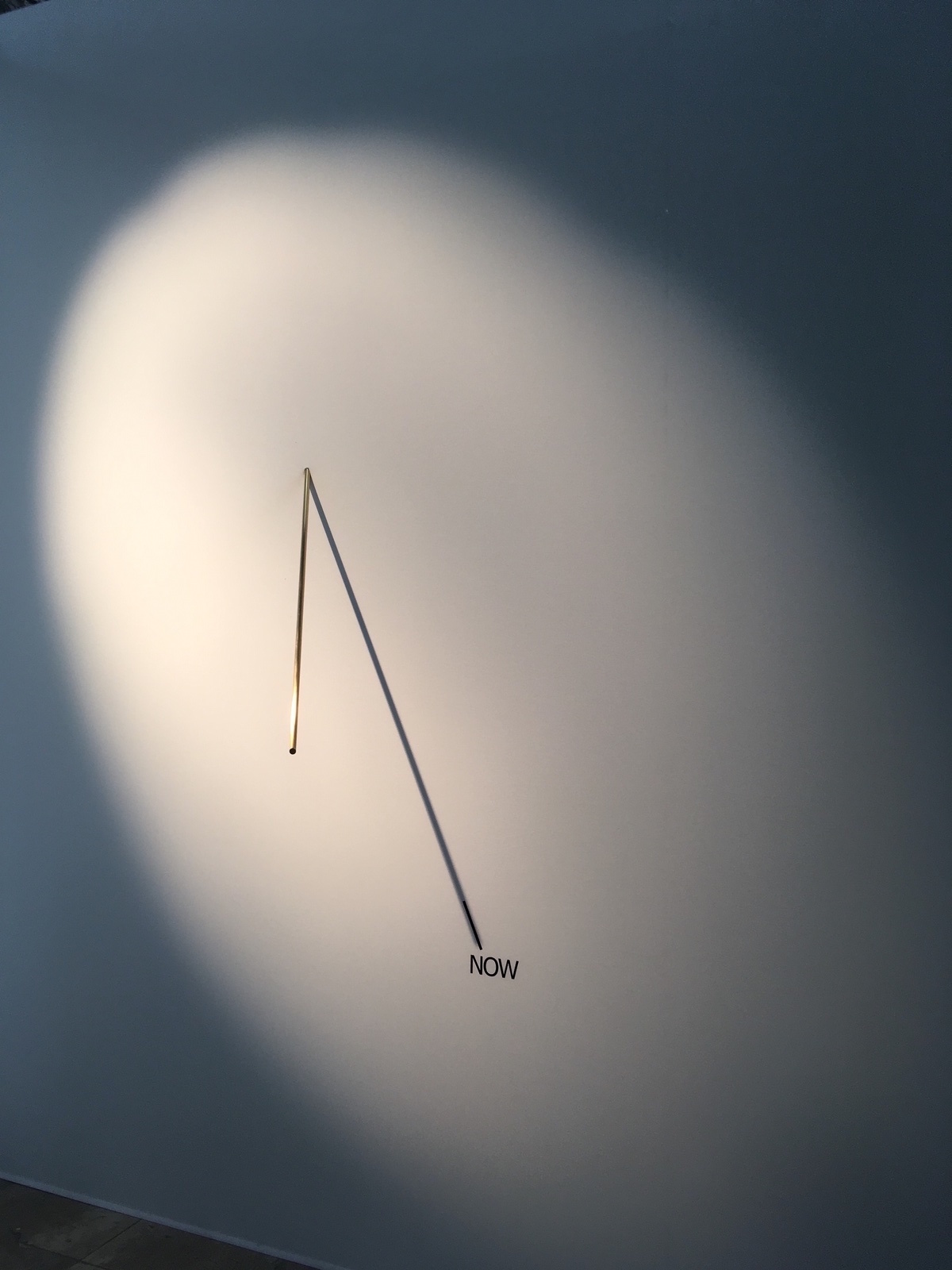
Variable dimensions
This piece is composed by a brass shaft directly inserted into a wall and a halogen spot light. This produces a shadow on the wall, the word NOW is written underneath.

25'59''
Sediments shows the double journey of an isolated young men, walking around a small town which seems to be abandonned, on the ocean front. Through his investigations in this landscape, he discovers a peculiar object which leads him to continue his researches, across remains of the past.
With Antoine Loubry
Director of photography: Charles Devoyer
Sound engineer: Alexandre Lemore
Director of photography assitant: Rémy Peslouan
Script: Amélie Forestier
Production management: Thomas Merret
Color correction: Richard Pelmar
This film has been produced thanks to DRAC Île-de-France and Direction des affaires culturelles de la Ville de Paris.
©2013 Julien Discrit
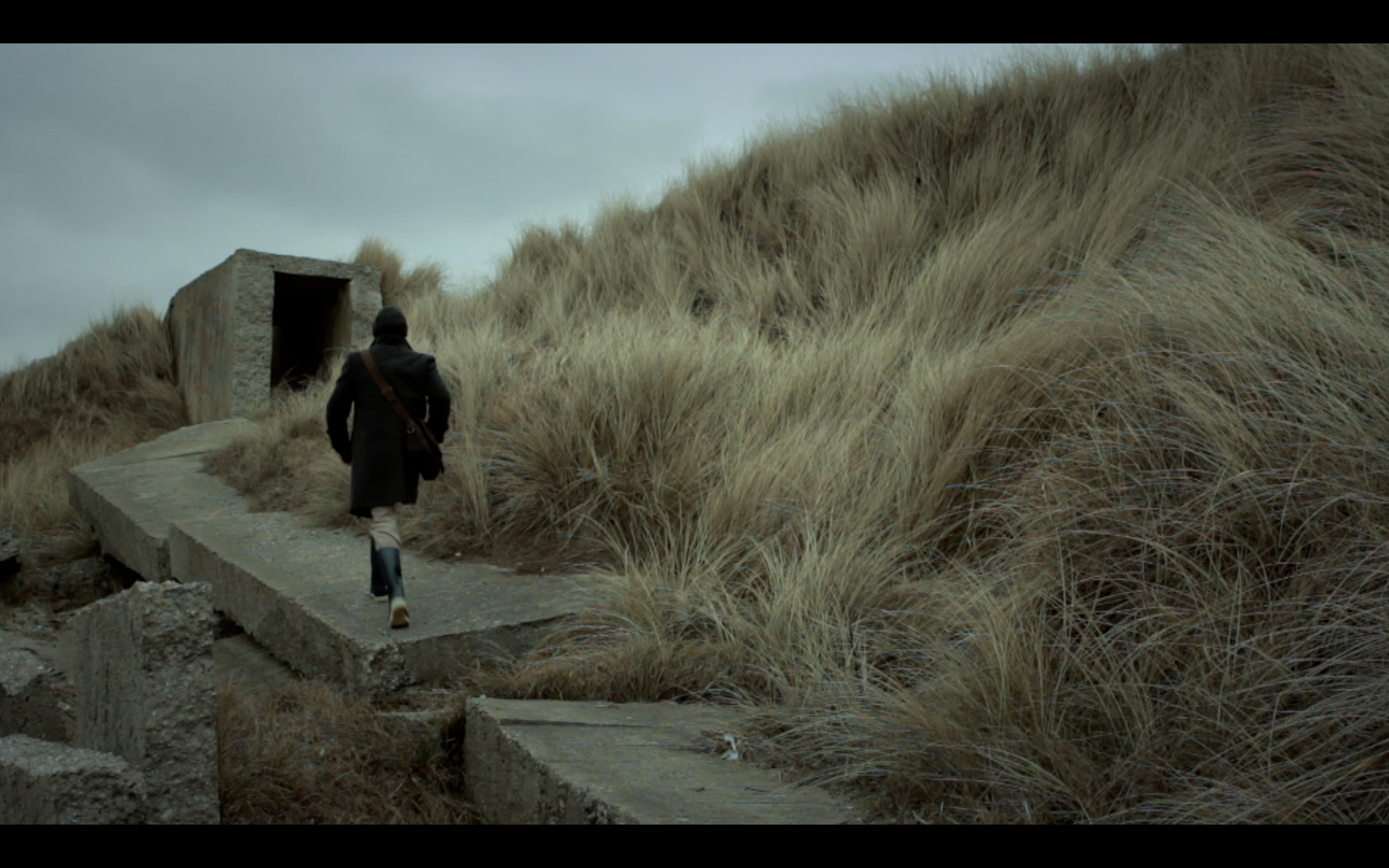
25'59''
Sediments shows the double journey of an isolated young men, walking around a small town which seems to be abandonned, on the ocean front. Through his investigations in this landscape, he discovers a peculiar object which leads him to continue his researches, across remains of the past.
With Antoine Loubry
Director of photography: Charles Devoyer
Sound engineer: Alexandre Lemore
Director of photography assitant: Rémy Peslouan
Script: Amélie Forestier
Production management: Thomas Merret
Color correction: Richard Pelmar
This film has been produced thanks to DRAC Île-de-France and Direction des affaires culturelles de la Ville de Paris.
©2013 Julien Discrit

25'59''
Sediments shows the double journey of an isolated young men, walking around a small town which seems to be abandonned, on the ocean front. Through his investigations in this landscape, he discovers a peculiar object which leads him to continue his researches, across remains of the past.
With Antoine Loubry
Director of photography: Charles Devoyer
Sound engineer: Alexandre Lemore
Director of photography assitant: Rémy Peslouan
Script: Amélie Forestier
Production management: Thomas Merret
Color correction: Richard Pelmar
This film has been produced thanks to DRAC Île-de-France and Direction des affaires culturelles de la Ville de Paris.
©2013 Julien Discrit
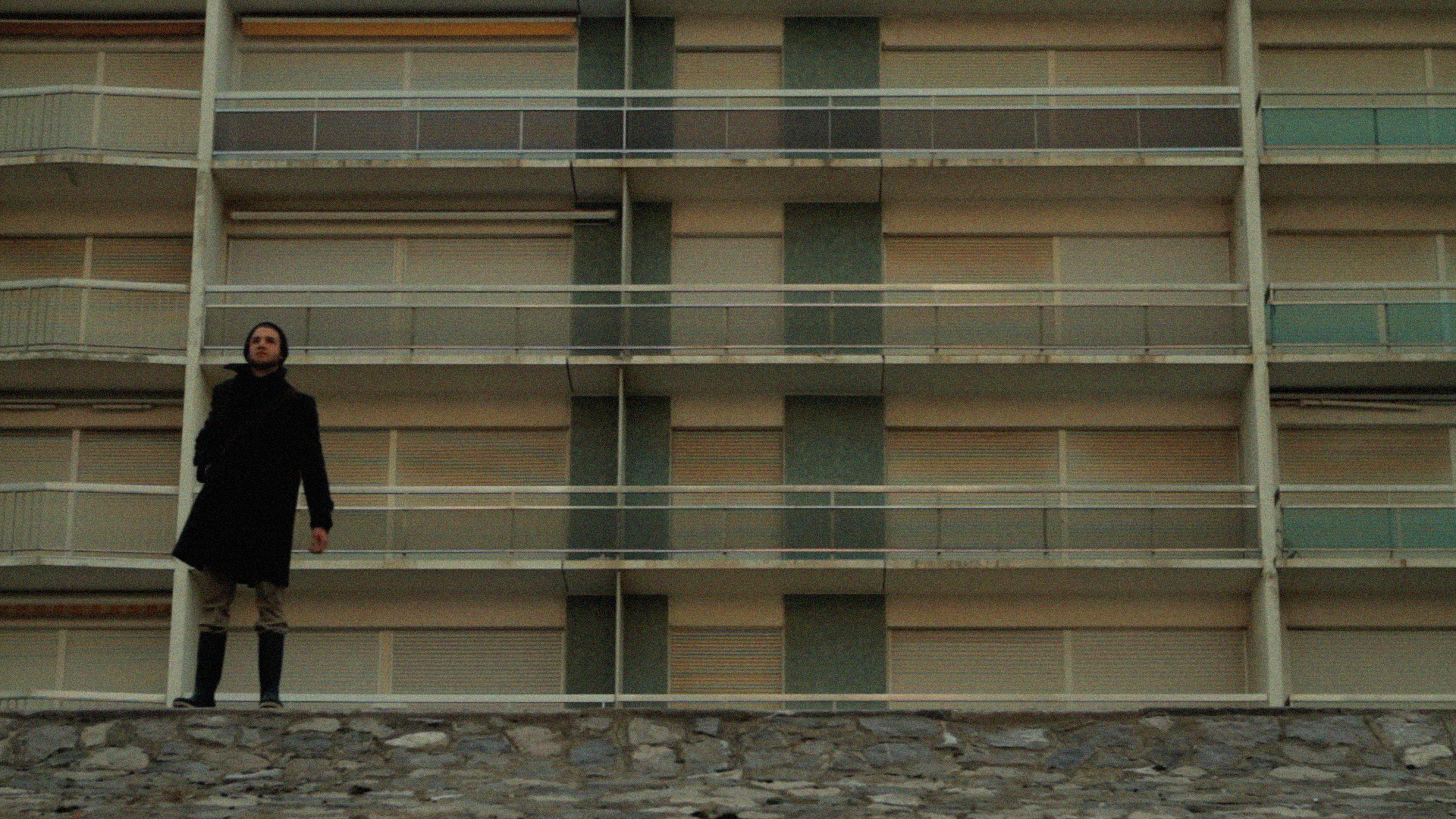
25'59''
Sediments shows the double journey of an isolated young men, walking around a small town which seems to be abandonned, on the ocean front. Through his investigations in this landscape, he discovers a peculiar object which leads him to continue his researches, across remains of the past.
With Antoine Loubry
Director of photography: Charles Devoyer
Sound engineer: Alexandre Lemore
Director of photography assitant: Rémy Peslouan
Script: Amélie Forestier
Production management: Thomas Merret
Color correction: Richard Pelmar
This film has been produced thanks to DRAC Île-de-France and Direction des affaires culturelles de la Ville de Paris.
©2013 Julien Discrit

23,6 x 15,7 inches
Exhibition:
- Le souvenir des pierres, Galerie Anne-Sarah Bénichou, Paris, 21st May-16th juiy 2016
- Loin des yeux, Centre d'art contemporain de Montréal, du 16 avril au 11 juin 2016
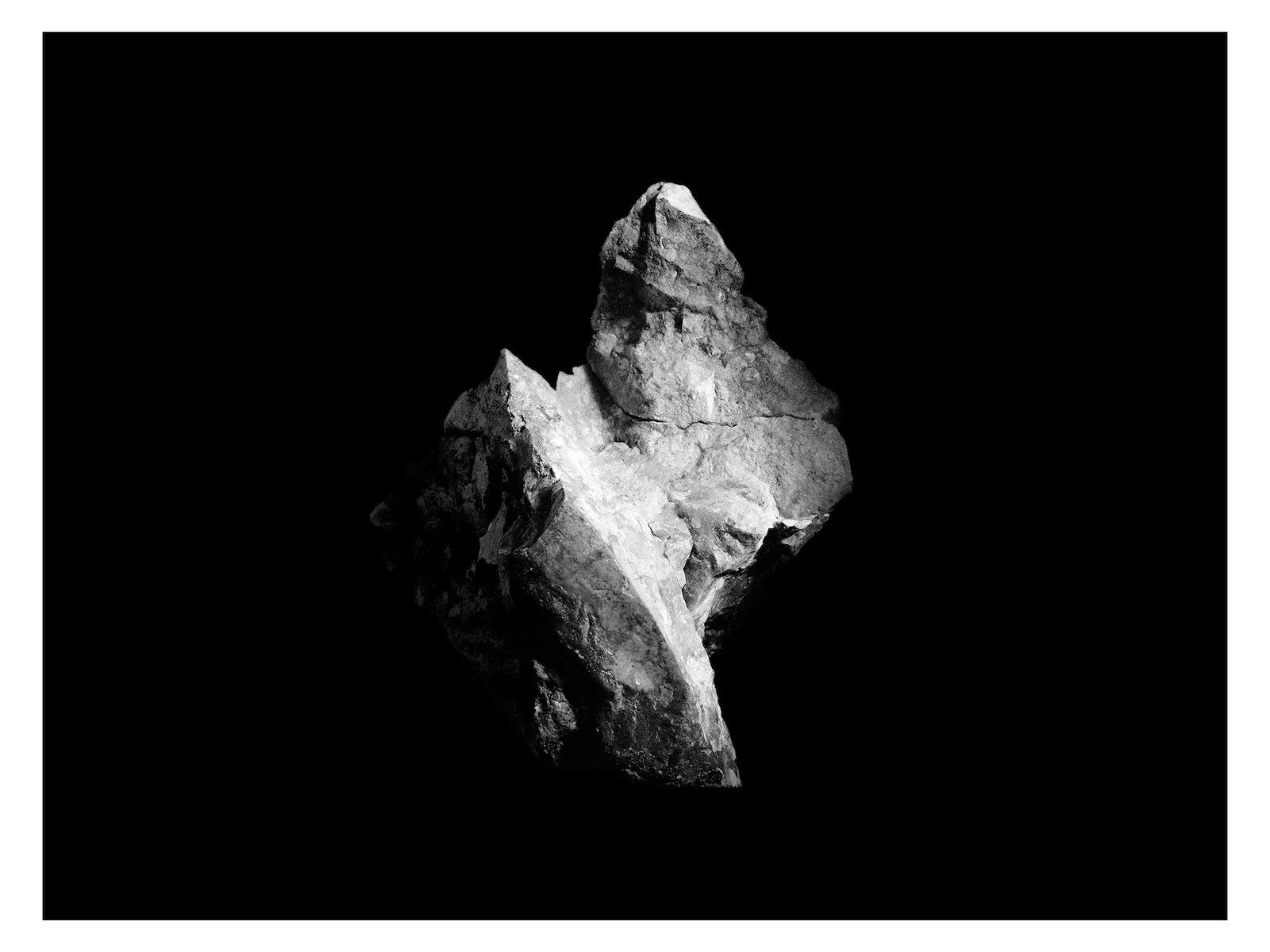
Image: 60 x 80 cm
Frame: 62 x 82 cm
The Mont Analogue series portrays little stones, collected for their strong resemblance with mountainous massifs, and plays with the concept of scale. The adopted vantage point in this photograph accentuates the loss of spatial markers and embraces the practice of rescaling from microcosm to natural topography.

Image: 60 x 80 cm
Frame: 62 x 82 cm
The Mont Analogue series portrays little stones, collected for their strong resemblance with mountainous massifs, and plays with the concept of scale. The adopted vantage point in this photograph accentuates the loss of spatial markers and embraces the practice of rescaling from microcosm to natural topography.

Image: 60 x 80 cm
Frame: 62 x 82 cm
The Mont Analogue series portrays little stones, collected for their strong resemblance with mountainous massifs, and plays with the concept of scale. The adopted vantage point in this photograph accentuates the loss of spatial markers and embraces the practice of rescaling from microcosm to natural topography.

Variable dimensions
Sédiments series seeks to account for microscopic phenomena. It is the result of sedimentation, literaly as well as figuratively, of a slow time work on some elements that combine and transform to create a "fossil object", the memory of a past experience and the trace of a future sediment.
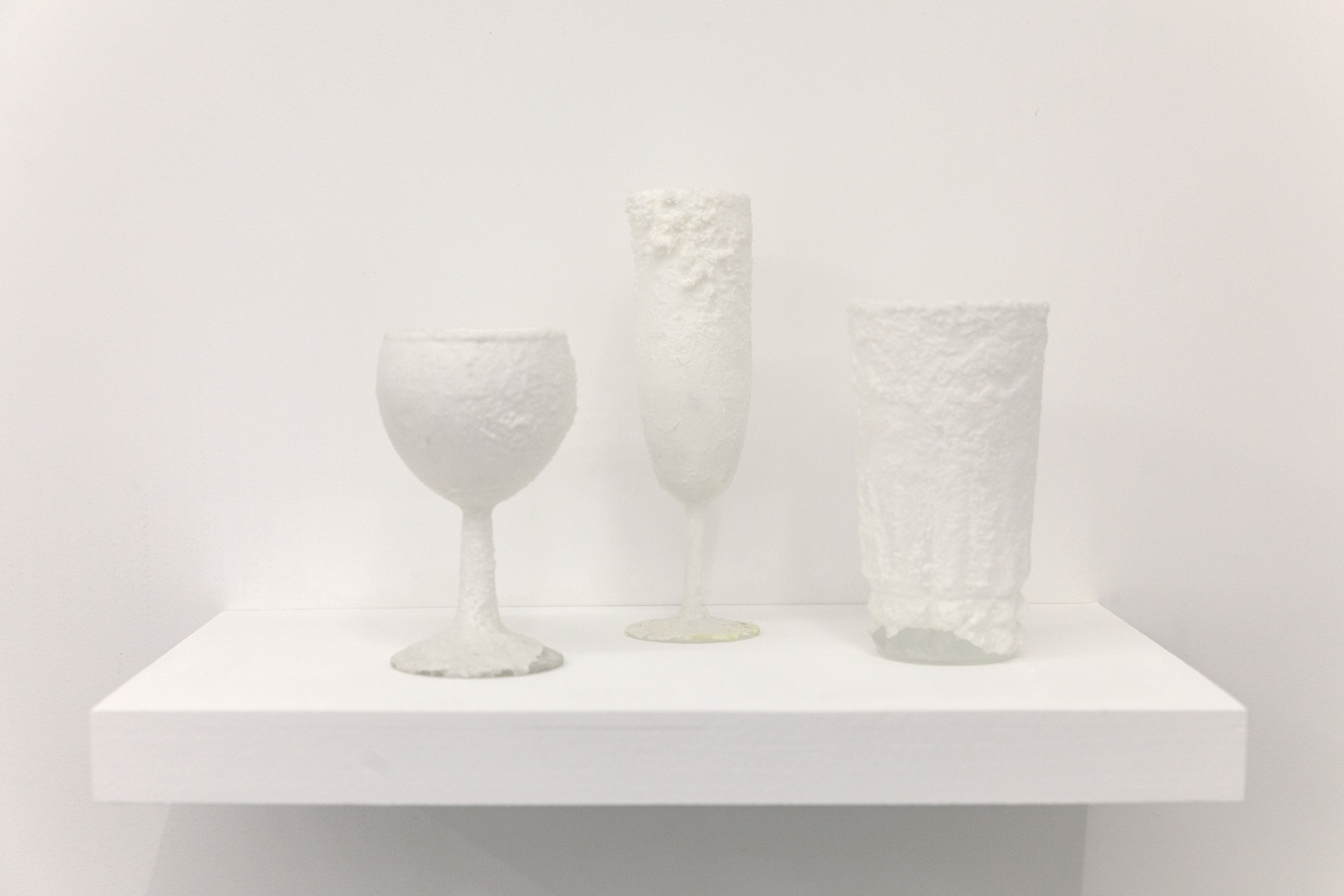
Variable Dimensions 8,7 x 6,8 x 5,1 in
Sédiments series seeks to account for microscopic phenomena. It is the result of sedimentation, literaly as well as figuratively, of a slow time work on some elements that combine and transform to create a "fossil object", the memory of a past experience and the trace of a future sediment.

Embossed notebook page
8,3 x 5,1 in
Each Diagram offers the story of a selected dream made by the artist, realised on a notebook page. By removing the ribbon from a typewriter, the paper has been carved to create the letters and the words which make these scripts visible for our eyes.
Text
Je suis à Berlin, la ville est composée en croix avec de chaque côté des collines assez hautes. En haut de l'une d'elles, dans un hôtel de luxe, se tient une exposition. Pour s'y rendre le bus emprunte des routes de montagnes très escarpées, en passant les virages je vois des affleurements de roche blanche très particuliers, puis des roches translucides, comme du quartz rose et vert. C'est absolument magnifique. Au centre de l'exposition se trouve un grand crâne en silicone transparent. À l'intérieur de celui-ci on distingue l'empreinte d'un autre crâne. L'ensemble forme donc une sorte de membrane. À côté se trouve une paire de longs gants, sur ce même principe. Pour me montrer la finalité de son projet, l'artiste Christian Anderson enfile cette sorte de cagoule et je vois donc sa tête à l'intérieur de cette gangue, se superposant au profil du crâne dont il a fait le moule. La cagoule, ainsi que la paire de gants sont présentées dans une caisse en bois, où des cavités recueillent les objets.

4,7 x 6,3 x 1,8 in
In july 2009, during a trip into Mojave desert the artist filled two empty 135mm color roll film boxes with earth sample. Back in France he found these two boxes again, among other relics. Thanks to a riddle system of different sizes this earth has been sorted and put into test tubes in order to discover what the desert is made of.
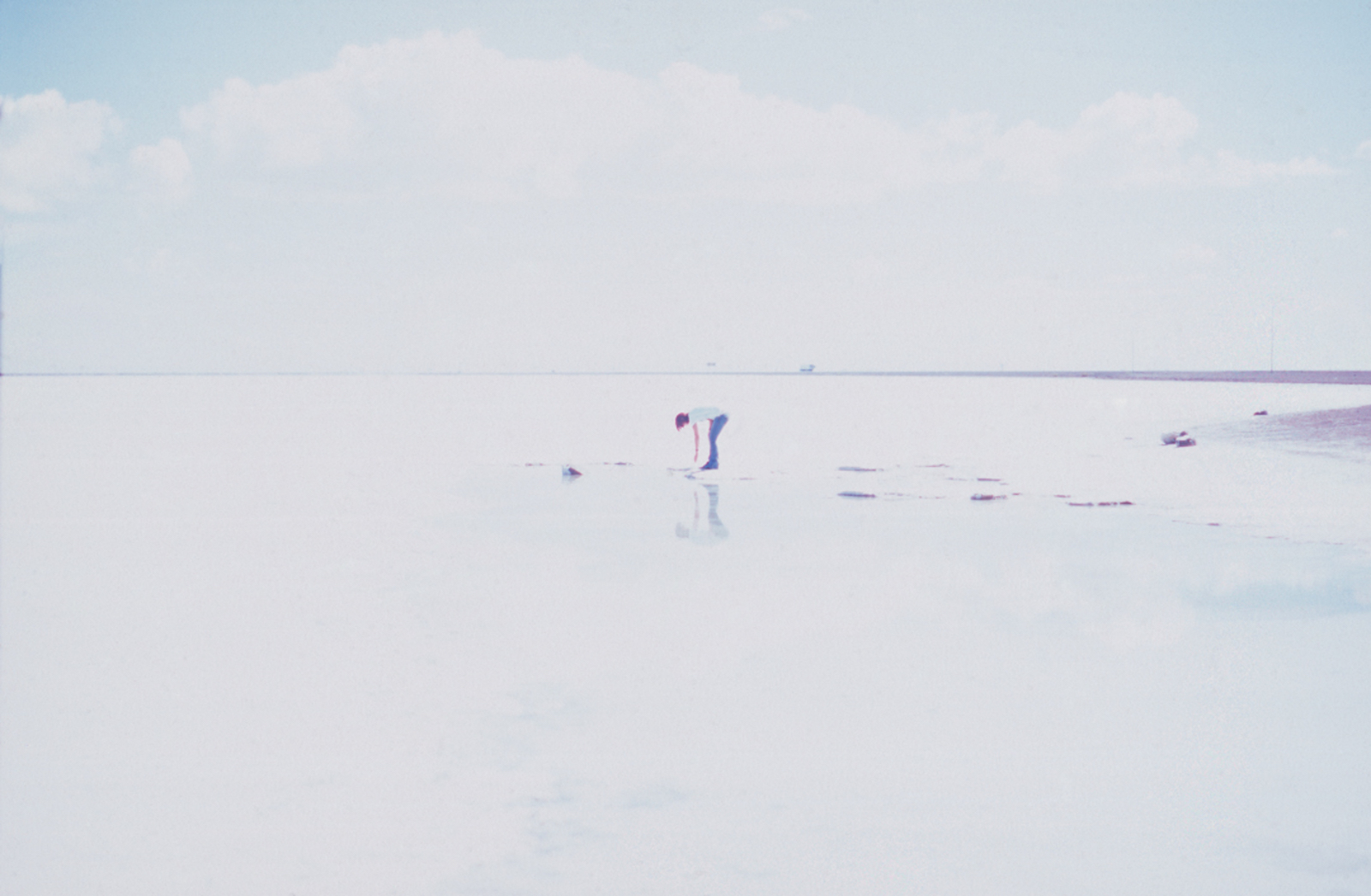
Lambda print
Image: 3,5 x 4,7 in
Frame: 9,8 x 11 in
Vanishing Island is a pictures series captionned on the natural site of Bonneville Salt Flats during a stay of the artist in USA. This huge salt desert, former bed of a giant lake, is in the north-east of Utah. Its characteristic is that it is the largest flat surface in the world. Its singularity regularly leads it to constitute itself as a theater of records, in particular during Speed Week, a week of speed car races. It is also a source of inspiration for artists like Nancy Holt and her Sun Tunnels.
Julien Discrit, in a series of five photos, uses overexposure to accentuate the loss of landmarks provided by this white and uninterrupted expanse. During the same stay, he produced a video called Speed of eye.

Lambda print
Image: 3,5 x 4,7 in
Frame: 9,8 x 11 in
Vanishing Island is a pictures series captionned on the natural site of Bonneville Salt Flats during a stay of the artist in USA. This huge salt desert, former bed of a giant lake, is in the north-east of Utah. Its characteristic is that it is the largest flat surface in the world. Its singularity regularly leads it to constitute itself as a theater of records, in particular during Speed Week, a week of speed car races. It is also a source of inspiration for artists like Nancy Holt and her Sun Tunnels.
Julien Discrit, in a series of five photos, uses overexposure to accentuate the loss of landmarks provided by this white and uninterrupted expanse. During the same stay, he produced a video called Speed of eye.
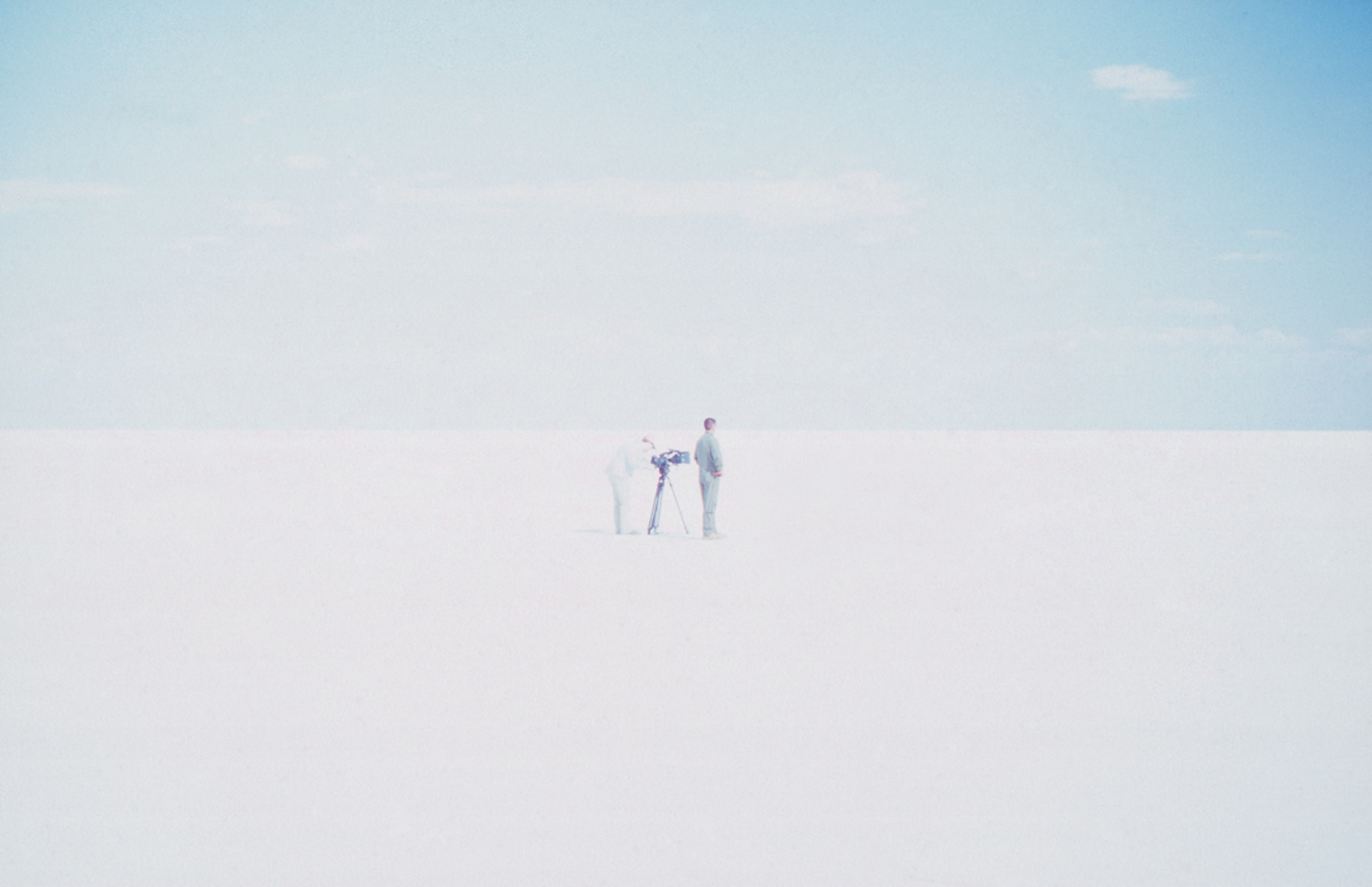
Lambda print
Image: 3,5 x 4,7 in
Frame: 9,8 x 11 in
Vanishing Island is a pictures series captionned on the natural site of Bonneville Salt Flats during a stay of the artist in USA. This huge salt desert, former bed of a giant lake, is in the north-east of Utah. Its characteristic is that it is the largest flat surface in the world. Its singularity regularly leads it to constitute itself as a theater of records, in particular during Speed Week, a week of speed car races. It is also a source of inspiration for artists like Nancy Holt and her Sun Tunnels.
Julien Discrit, in a series of five photos, uses overexposure to accentuate the loss of landmarks provided by this white and uninterrupted expanse. During the same stay, he produced a video called Speed of eye.

Lambda print
Image: 3,5 x 4,7 in
Frame: 9,8 x 11 in
Vanishing Island is a pictures series captionned on the natural site of Bonneville Salt Flats during a stay of the artist in USA. This huge salt desert, former bed of a giant lake, is in the north-east of Utah. Its characteristic is that it is the largest flat surface in the world. Its singularity regularly leads it to constitute itself as a theater of records, in particular during Speed Week, a week of speed car races. It is also a source of inspiration for artists like Nancy Holt and her Sun Tunnels.
Julien Discrit, in a series of five photos, uses overexposure to accentuate the loss of landmarks provided by this white and uninterrupted expanse. During the same stay, he produced a video called Speed of eye.
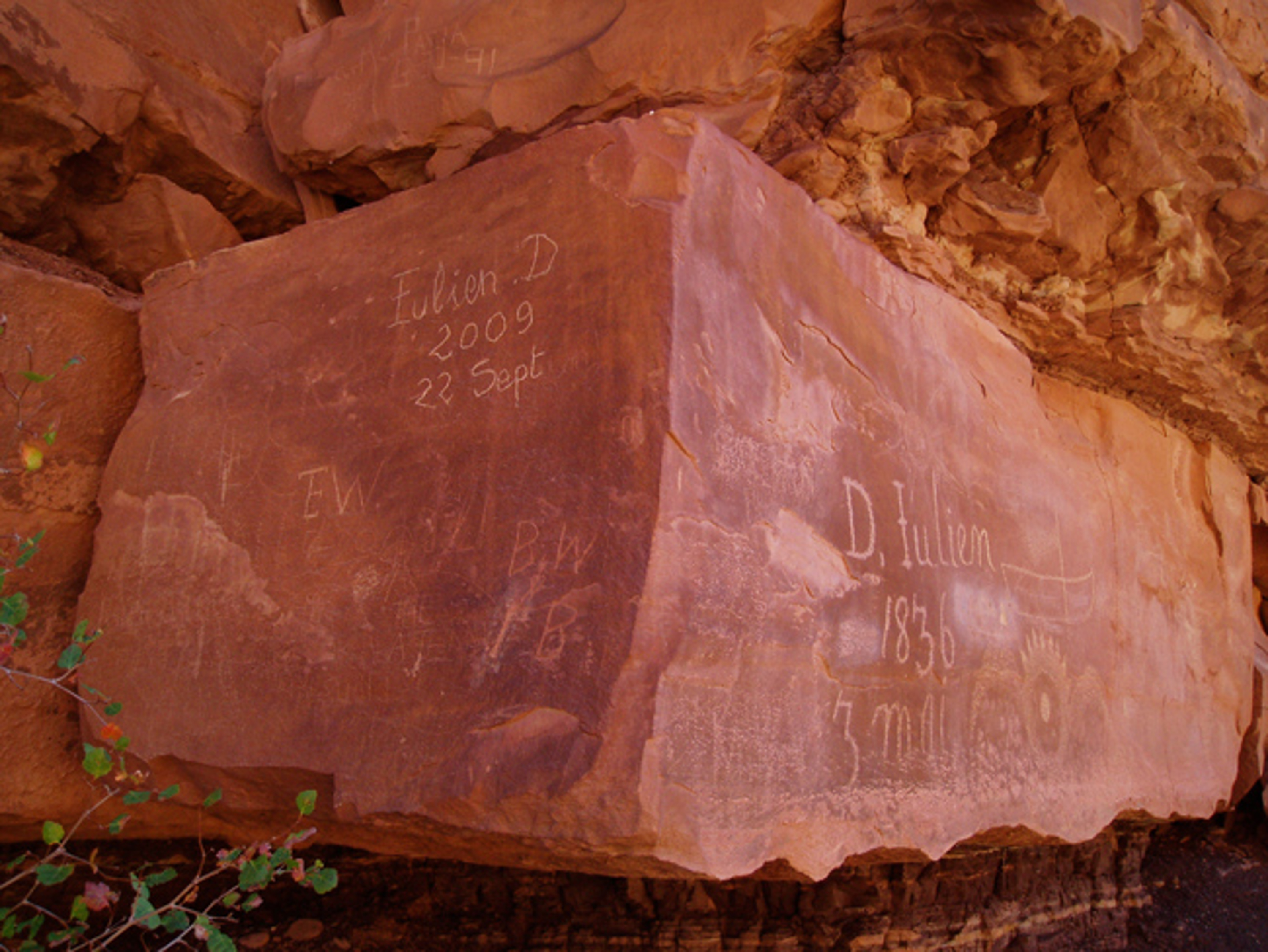
Image: 9,4 x 12,6 in
Frame: 14 x 17,1 in
On May 3, 1836, a man named “D.Julien” engraved his name on the sides of Labyrinth Canyon, in the meanders of the Green River, in southern Utah. With this inaugural gesture, he left the testimony of the first known European to have penetrated this remote area, while at the same time opening the way to other graffiti, other signatures. Some 173 years later, the artist goes in search of this homonymous double. The photograph Looking for D.Julien -Labyrinth Canyon- relates this experience linked to identity, to the passage of time and to the importance of the trace.
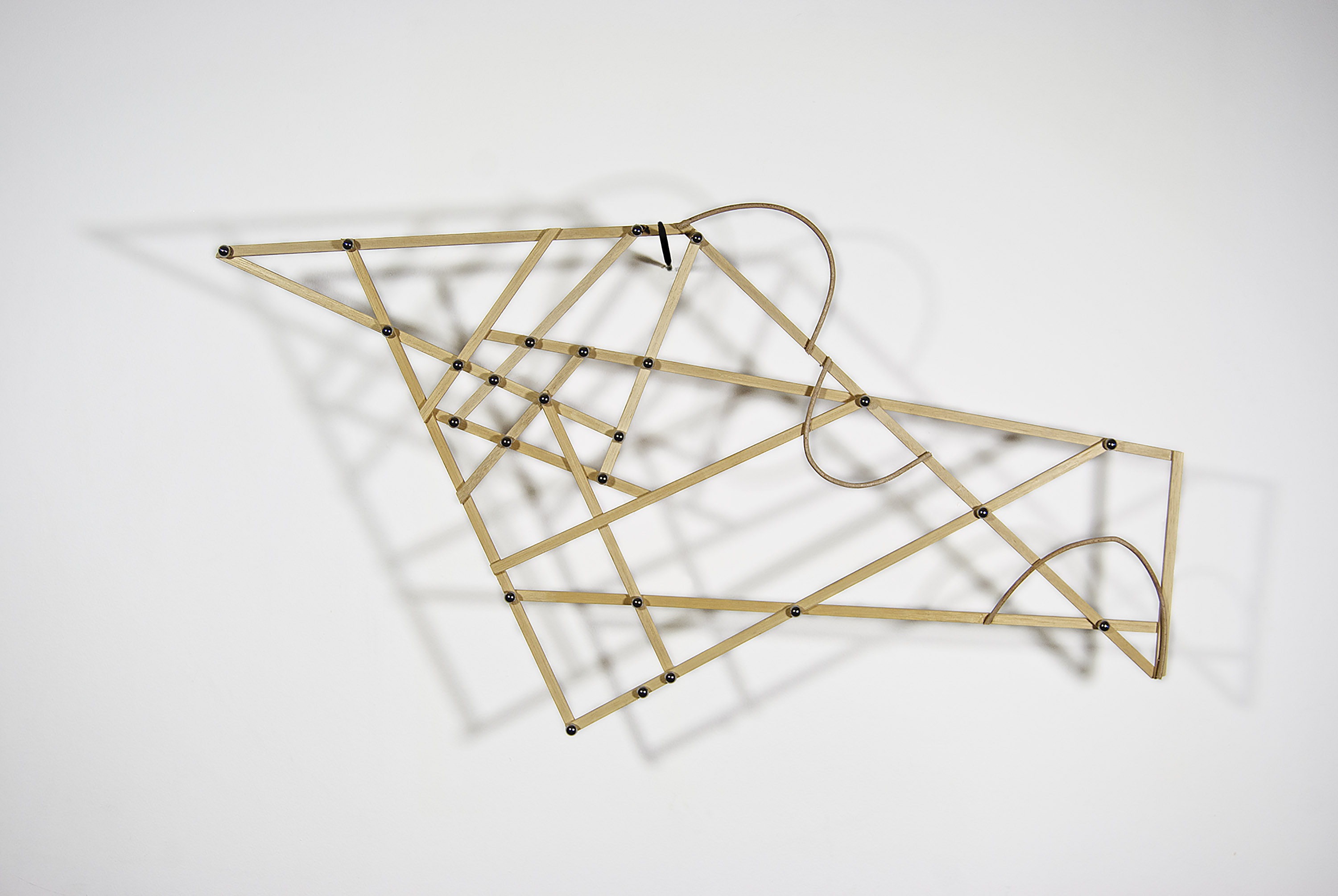
15,7 x 29,5 x 0,8 inches
Exhibition:
- "ZONES SENSIBLES. La carte fait-elle le monde ?" 24 juin au 23 octobre 2016, Frac Lorraine, Metz.

Variable dimensions
Vue de l'exposition "What is not visible is not invisible", Musée national de Singapour, Singapour,
Collection Frac Lorraine, Metz, France
Exhibitions:
- Persona Grata, MAC VAL, Vitry-Sur-Seine, France, 2018
- Mondes flottants, Biennale de Lyon, curator Emma Lavigne, Musée d'Art contemporain, Lyon, 2017
- What is not visible is not invisible, National Museum of Singapore, Singapore, Song Eun Art Space de Séoul, South Corea, and BACC of Bangkok, Thailand, 2016-2017
- La consistance du visible, Prix Fondation d’entreprise Ricard 2008
Collection Frac Lorraine, Metz, France

11 x 14,9 x 3,5 in
As a between-two surface, an uncertain line of contact, Inframince (Mont-Blanc) is a white stele topped by a transparent and luminescent block of resin. That subtle glow underline the thin opaque membrane which seems to divide the block in two, and draws an uneven relief, miniature size. This tiny thickness materializes, inside the block, the impalpable limit between sky and mountain.
Collection FRAC Lorraine, Metz, France
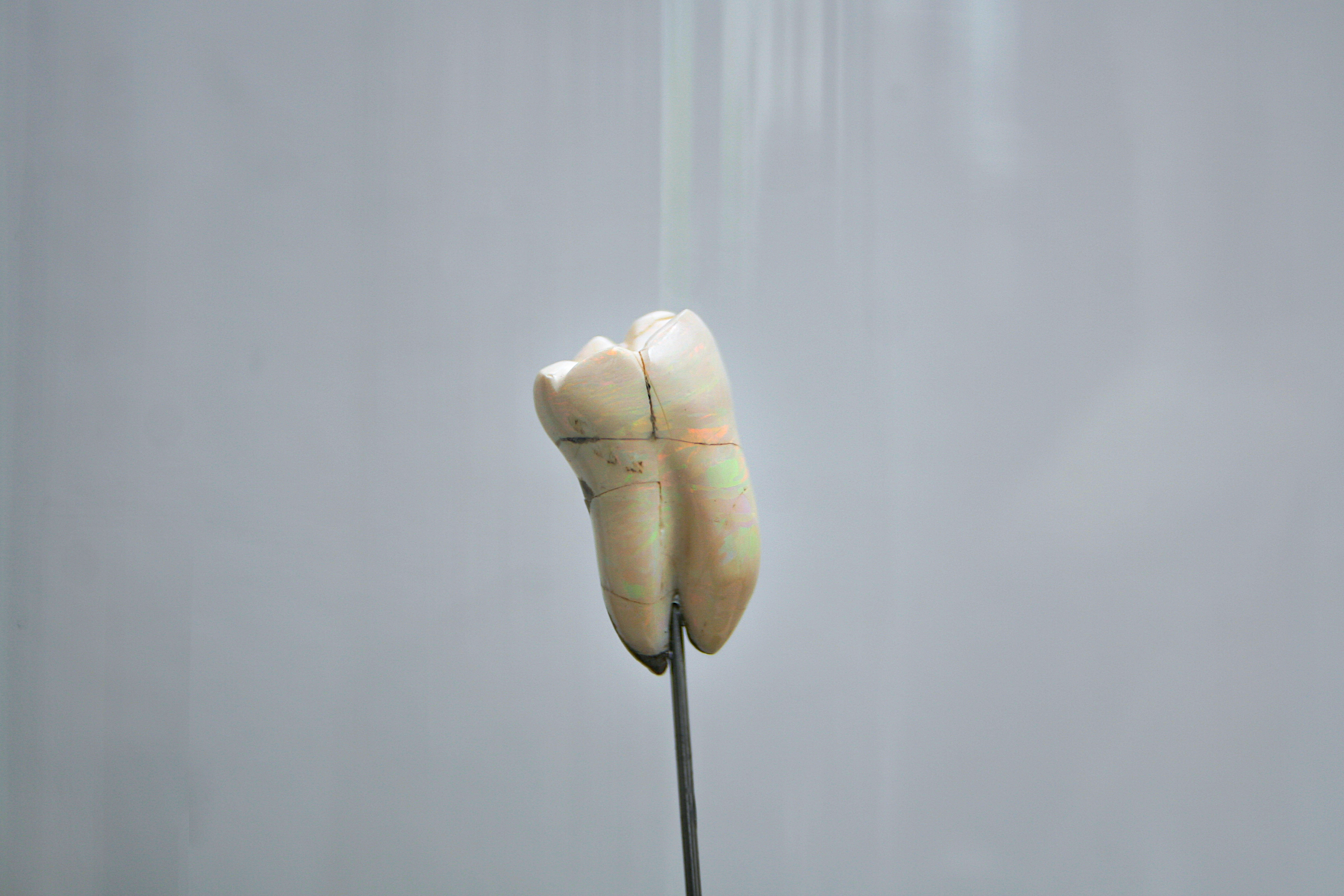
1 x 0,5 x 0,4 in
Opal is a crystalline stone whose crystals only form in pseudomorphosis, that is to say by transformation of an existing solid, the most frequent being those of wood, shells and bones. This idea of slow transformation of bone material into mineral is taken up here by the shaping of a white opal in the shape of a human tooth, like the residue of a fictive skeleton or the creation of a future fossil.

34 x 36 inches
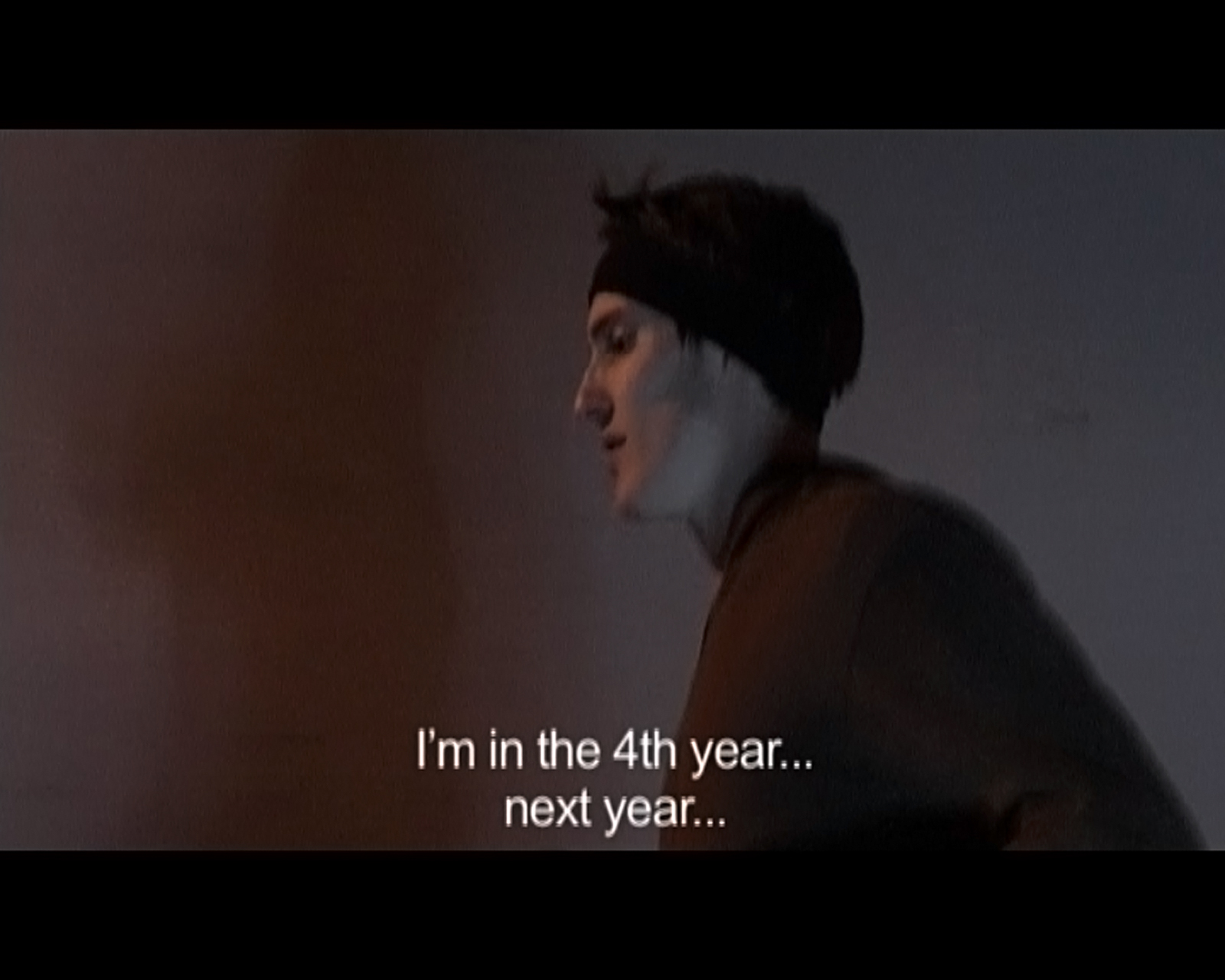
15'40'' min
Crédit photo Julien Discrit-And Factory,
Courtesy de l'artiste et galerie Anne-Sarah Bénichou
Collection Musée d'art Moderne de la ville de Paris
A young man emerges from a tunnel. His running is punctuated by his voice, he is talking to himself. The city he is running through seems to be deserted. It forms behind him a luminous and ghostly background. His monologue starts rather curiously; it is about toys, primary school? What he is talking about, as his running continues, is the story of his life. A life we do not know at first whether it is only fantasized or really true. Through this narration in the first person, he unfolded with each new stride, the story of his life.
Julien Discrit is a French visual artist. His work focuses on physical or biological processes through their technical capacity to generate forms. He questions both their emergence and their representation, seeing them as the result of an experiment. Using a wide variety of techniques and materials, his work draws on both geomorphology and neuroscience, all phenomena whose traces make up the artist's work. His works can be seen as so many imprints that evoke a memory that is both collective and personal; an experience of time and of a world that is constantly metamorphosing.
He has taken part in numerous solo and group exhibitions. His work was featured in the 2011 exhibition Sublime, les tremblements du monde at the Centre Pompidou-Metz, and at the Lyon Biennial in 2011, 2017 and 2024 and is part of several public and private collections. He is the recipient of numerous prizes and grants, including the Fondation des artistes in 2016 and 2022, the Fawu Prize and the 1% art market grant from Crédit Municipal in 2019.
Julien Discrit lives and works in Paris.